How to Write a Winning Proposal Cover Letter (Plus 5 Real Examples)

First impressions are important—especially in the world of proposals.
That’s why writing a good cover letter is an essential step towards winning a bid. In the request for proposal (RFP) process, this single-page letter marks your first opportunity to grab a prospect’s attention and make it clear that your company is uniquely positioned to solve their problem. So if you’re currently using boilerplate copy… Stop. Immediately .
In this blog, you’ll learn how to write custom proposal cover letters that grab a prospect’s attention and increase your chances of winning RFP responses . Plus, five examples of real proposal cover letters from industry pros.
In this article, you’ll learn:

What is a Proposal Cover Letter?
- What to Include in a Proposal Cover Letter
- How to Write a Proposal Cover Letter
- 5 Real Proposal Cover Letter Examples ⭐
Next Steps: Build Quality Proposals Faster
A proposal cover letter is a single-page document used to pitch your business offerings to a potential client. In it, the customer can tell whether you’re genuinely engaged and have done your research—or if you’ve simply copy and pasted generic language from past business proposals.
It’s also your first opportunity to convince a client to why they should continue reading your proposal. Considering the average team spends 32 hours writing a single RFP response , it’s critical that your proposal cover letter makes a good impression.
“This is the most important five paragraphs one can write as it’s the only part everyone will read. You must knock it out of the park or you’ll lose.”

What Should You Include in a Proposal Cover Letter?
Like any good cover letter, your proposal should open with a unique offer or positioning. It’s important to establish early on why your team is best suited to solve a client’s problem.
A strong proposal cover letter includes:
- A greeting : Introduce your company and what you do.
- Clear summary: Describe your value propositions at a high-level. Be sure to connect these points to your client’s needs. ( Also known as an executive summary. )
- Personalized offer: Explain to the client what you can uniquely provide to solve their problem.
- Relevant references: Help the prospect understand why they should choose you over competitors.
- Visuals: If you have a designer on your team, include visuals that help emphasize the most important content on this page. For example, use callout boxes to make value propositions stand out for busy procurement teams who are skimming the page.
From the offer you present, to the visuals you include, the details in your proposal cover letter should be all about the client. The goal is to show how your company shines before they even get into the details of your proposal. Demonstrate the qualities that you bring to this potential customer by starting out your relationship on the right foot.
Jon Williams, Managing Director of Strategic Proposals , shares the key points you should concisely hit to be successful.
“Thank the customer, show enthusiasm, demonstrate senior sponsorship, briefly introduce win themes–and then shut up and leave the rest to a brilliant exec summary!”

How to Write a Winning Proposal Cover Letter
From reading the RFP thoroughly, to outlining a clear offer, there are six critical steps that seasoned proposal professionals recommend you take to craft a quality cover letter. ( Psst…you can fast-track these steps by using AI for proposal writing . )
Step 1: Read the RFP Cover to Cover
This step seems obvious, but it’s surprising how many teams skip it. You must read the RFP thoroughly, from cover to cover, before beginning your letter.
While reading, take note of any recurring themes from your prospect. Perhaps they focus on quality of design and ease of use. Or maybe they emphasize needing certain functionalities or features—whatever the case, Kori Warriner of KCI Technologies recommends you consider the following questions as you read through the request for proposal:
Questions to consider:
- What is the client’s reason behind the project? (revitalization, aging infrastructure, etc.)
- Where is the funding for the project coming from?
- Does the client have any hot-button issues regarding the project?
- What is the desired end-result?
- What would speak to the client? (retirement-friendly, aesthetics, budget, etc.)
“You need to make the client feel as though you are speaking directly to them.”

While questions may differ by industry, the idea remains the same. Reading the RFP thoroughly helps you better understand the problems your prospect is facing. Which in turn help you paint a clearer picture of how your company can support them.
(It can also help spark ideas for win themes, or specific language, that truly resonates with the prospect—more on that later.)
“Instead of saying ‘we are pleased’ or other overused statements such as that, I introduce my company, and then switch back to talking about what we can do to help the client reach their goals,” Kori explains.
Step 2: Capture Your Prospect’s Attention Early
Chances are, your prospect is extremely busy. They’re likely to skim your proposal cover letter—which is why you should focus on making it memorable. Use it to create a connection to your prospect and capture their attention early in the proposal.
In the structure of a proposal , the first paragraph is the best place to earn your reader’s attention, shares Senior Proposal Consultant Kelly Allen.
“Try to capture the reader in the first paragraph by relating to them in some way. If they are a current client, leverage your relationship. If not, demonstrate a clear understanding of what they need.” Kelly Allen, Senior Proposal Consultant, UKG (Ultimate Kronos Group)
Step 3: Use Clear, Competitive Win Themes
Once you identify their distinct needs, you can formulate which key themes need to be identified in your cover letter. Then, narrow it down to the most persuasive reasons that your prospect should choose your proposal over a competitor. Eileen Kent, President of Custom Keynotes, explains that these are also known as “ win themes ”.
Win themes should be based on what the customer told you they wanted. Position yourself as the one company that can deliver exactly what your prospect is looking for. To do this well, it’s essential that you also understand what your competition is doing.
Here’s how to brush up on what your competitors are offering:
- Review competitors’ websites
- Read competitors’ financial statements
- Look at review websites like G2 or Forrester reports including your competition
- Ask if clients are willing to share competitors’ past RFPs (You never know, unless you ask)
At this stage, you’ll want to focus on how you can stand out from the competition. Eileen also recommends acknowledging any elephants in the room. By that, she means anything that the client may consider your team’s weakness.
She recommends addressing weak points head on to leave a good impression, “The elephant in the room could be your business size. Address it by talking about how you formed a tight team who have exceeded performance expectations, and worked together for years, so they see that as a strength instead,” she explains.
Step 4: Provide a Personalized Offer
Now that you’ve grabbed your prospect’s attention, you need to maintain it. Do this by outlining clear benefits, which speak directly to their pain points in an enticing and clear way.
You should outline how your product will positively impact the buyer and identify what they will get out of your partnership.
“Choose the top 3-5 features of your solution and describe how they will benefit your customer in a single line. Be direct: Here’s what we offer. Here’s how it will solve your problem.”

Step 5: Use a Strong Closing Statement
Your closing statement should be concise, reiterate your capabilities, and highlight the value you deliver. But don’t forget that it’s also an opportunity to connect with your prospect through the proposal process.
“To build a connection, you have to ignore outdated writing advice and not be afraid to use real language” says Rebecca Baumgartner, Sr. Manager, Proposals, PFS .
“Whoever is reading your cover letter can immediately tell if you’re hiding behind jargon or parroting the language of the RFP because you don’t understand what they need,” she explains.
“But when you write authentically, you have the opportunity to show the client you’ve been listening.”
“A great cover letter isn’t stuffy or formal–it’s a conversation between real people, a chance to put aside the technical language of procurement and connect with the human being on the other side.”

Step 6: Add the Finishing Touches
When crafting your proposal cover letter, there are a few final checkpoints to leave your prospect with a good impression.
Graphics aren’t necessary for a proposal cover letter, but they can be helpful. For example: highlighting a quote from a customer in a different font, or using callout boxes to emphasize your key value propositions. Use visuals that help to emphasize your main points, not distract from them.
Here’s what Izane Cloete-Hamilton, CPP APMP, of nFold recommends.
- Use a company letterhead
- Address the letter to the individual specified in the RFP
- Sign the cover letter from a senior person at your company
- If the response is from a strategic partnership between two companies, use dual signatures
- Ensure your letter is no longer than one page
“Sign the proposal cover letter from the highest-level person with signature authority, preferably someone that the customer knows personally.”

Proposal Cover Letters (5 Real Templates)
Now that you know what steps to follow, it’s time to look at some real examples of business proposal cover letters. While you don’t want to copy a boilerplate letter, these templates may provide helpful guidance for your next proposal.
Here are the types of proposal cover letter examples you’ll see above:
- Real proposal cover letter example from a security company
- Example proposal cover letter for an amusement park
- Real proposal letter & executive summary from an enterprise design consultancy
- Winning cover letter example from KCI technologies
- Another proposal cover letter example from a security company
Looking for a sample grant proposal cover letter? Check out this article .
“Remember, your cover letter isn’t about you, it’s about your client. Let them know that you understand them. Then you can talk about how your company can solve their potential challenge.”

To make more time for writing winning proposal cover letters, you’ll need to make some efficiency gains in your overall RFP process. Start by setting your team up with a proposal software that can improve speed and collaboration amongst your team.
Take Aspen Medical for example. Their business development team started using Loopio’s proposal platform in October of 2019. Within a few short months, they were putting together proactive proposals in just 15-30 minutes and seeing a big return on investment (ROI).
In fact, a survey of 165 companies RFP ROI found that those who consistently use proposal software have achieved results of:
- 51% more RFP responses
- 42% less time spent answering proposal questions
- 85% of companies win more business
If you’re looking to improve the pace of your next proposal, try Loopio’s software.
Improve Your Proposal Writing 📝
Want to learn how to master your craft? Read more about proposal writing skills or how to craft a repeatable RFP response template .
Related posts
51 fascinating rfp statistics on the state of bidding in 2024, the raci chart: how to respond faster to security questionnaires, how to transform your rfp process: best practices used by alight.
How to Write a Proposal Cover Letter: Examples + Free Template
Posted by: Cinthya Soto
Proposal cover letters are brief overviews that introduce the more in-depth content of a proposal. Cover letters are normally the first page of a proposal, making them the first impression you will give and your first opportunity to convince the reader to work with you. These letters directly communicate with the client and set the stage for the following proposal details.
If your proposal cover letter is not convincing enough, the reader might not read your entire proposal and choose a competitor. That’s why understanding the do’s and don’ts of proposal cover letter writing is crucial.
In this blog, we’ll teach you how to structure and write a proposal cover letter, what makes a good and a bad proposal, and we even provide a free downloadable template for your firm to use.
What Is a Proposal Cover Letter?
A proposal cover letter is a letter that accompanies an RFP response or bid submission. Its primary purpose is to introduce the proposal, explain its relevance to the recipient, and persuade the reader of the value and credibility of what’s being offered. It sets the tone for the entire proposal, so make sure it’s well-crafted.
The cover letter needs to be persuasive and blow your prospect away because it provides a first impression. Since it’s often the first thing the recipient will see, it plays a key role in the recipient’s decision to even consider reading the full proposal.
The cover letter is frequently the initial opportunity for your proposal to align with the reader’s objectives. While it goes on top of the proposal, it shouldn’t be confused with an executive summary that outlines the main highlights of your proposal.
Why Your Proposal Cover Letter Matters
Your proposal cover letter is made up of the most important paragraphs you’ll ever write because it’s the section everyone will read. That’s why it’s essential to nail it, or you stand the chance of losing the project. A cover letter helps busy clients decide if they’re interested in reading the complete proposal. Therefore, having a winning proposal cover letter is equally important as the actual proposal.
The proposal cover letter gives you a chance to leave clients with a memorable first impression. While proposals lean towards factual information, cover letters offer a more personal touch. Establishing an emotional connection from the beginning significantly increases the likelihood of the reader engaging with your entire proposal.
What Should Be on a Proposal Cover Letter?
Though the specifics of your proposal may vary based on the nature of your offer and your sector, the proposal cover letter should consistently stick to the following structure:
Contact Information
It’s essential to include your contact details, including your name, email, and phone number, as well as your organization’s information such as its name, email, phone number, website, and even its social media handles. For bonus points, include the link to your LinkedIn profile in the heading too so the reader can get a deeper understanding of who you are.
Make these details easy to find by placing them at the top or bottom of the cover letter, ensuring they’re in a bold and easy-to-read font so potential clients have no problem finding them. Using the company’s letterhead for the letter not only ensures the inclusion of this information but also gives a professional touch.
Greeting
This is your chance to introduce your company and what you do. It’s your first opportunity to make a positive impression and establish a connection with the reader.
Begin with a concise statement about your company. This could be your mission statement, a brief history, or an overview of what makes your organization unique. This is your chance to highlight areas where your company excels, which helps you establish credibility.
Additionally, highlight your primary areas of specialization or the main services/products you offer. This will give the reader a clear understanding of your role and what you do.
Summary
Often, decision-makers are drowned in proposals, and they might not have the time or patience to go through every detail initially. A concise summary ensures that they can quickly understand your proposal’s primary objectives and value.
You should provide details about your value propositions at a high level and connect how they meet your client’s requirements. By summarizing how your proposal addresses the client’s specific challenges or needs, you can instantly resonate with them, emphasizing that your solution is tailored to their situation.
Offer
Continuing to the offer, this is where you should further explain how you can provide a personalized solution. Clarify to the client the unique value your solution brings to solve their problem.
Having captured your potential client’s interest, you now have to focus on keeping it. Achieve this by highlighting the clear benefits that directly compellingly address their challenges, making it easy to understand.
While you’ll be mentioning how your work will benefit the prospect, you should also explain what they will win from choosing to work with you.
Here are some tips on how you can accomplish this:
- Select the three to five primary attributes of your solution
- Explain their advantages for your client in a concise statement
- Be straightforward– This is what we provide. This is how it solves your issue
References
In situations where multiple firms submit proposals, having strong and relevant references can set you apart from competitors. It offers an added layer of reassurance to prospective clients about your experience and competence. Essentially, relevant references help the client understand why they should choose you over others.
References also show the prospective client or partner that others have trusted you and that you’ve delivered results. By showcasing references from satisfied clients or partners, you demonstrate that you have been trusted in the past, which can solve any insecurity or concerns the potential client might have.
Visuals
Visuals aren’t a must for proposal cover letters. However, they can enhance its impact by emphasizing crucial information. If you have a designer on your team, you can incorporate graphics that highlight the key points of the letter.
Some examples of what this might look like:
- Highlighting a customer satisfaction quote in a different font to make it stand out
- Using callout boxes to draw attention to your key value propositions (especially helpful for busy teams skimming the page)
- Using the company letterhead
- Including the signature from a senior person at your company
Conclusion
Similar to introductions, many cover letters tend to focus more on the body content than the concluding paragraph. However, ending on a powerful note is as crucial as creating a compelling start. It’s recommended to conclude your cover letter by highlighting a significant benefit and the value your project will offer to the company.
Additionally, when wrapping up your proposal cover letter, always encourage them to continue by reading the complete proposal.
How to Write a Proposal Cover Letter
Now that you know the structure to follow on the proposal cover letter, it’s time to go into the details of how to write a proposal letter.
Powerful First Sentence
Starting with a powerful opening sentence can grab the reader’s attention immediately, encourage them to continue reading, and make your proposal stand out among the endless others they may have received. It’s beneficial to use impactful verbs and straightforward wording to ensure your initial sentence remains engaging and brief.
Demonstrate You Understand the Problem
In any proposal, it’s essential to demonstrate to your client that you understand the problem they’re facing. Highlight their goals and the reasons behind your collaboration. Present the company’s challenges in an easily comprehensible manner. Dedicate a section to focus on the company’s concerns, and later in the cover letter, you can introduce the proposed solutions.
Offer to Discuss the Proposal Further
Before ending your cover letter, you should stress your readiness to dive deeper into the proposal and address any questions or concerns the reader might have. Additionally, this serves as a chance for you to propose a face-to-face meeting with the potential client to further increase your chances of landing the project.
Thank the Issuer for the Opportunity
In the cover letter, you have the opportunity to express gratitude to the proposal’s recipients. Recognizing their participation in the process and expressing appreciation for the opportunity not only demonstrates courtesy but also signals to all reviewers that you’ve closely read the RFP guidelines.
Persuasive Closing
After completing the structure and details of your proposal cover letter, end with a persuasive closing demonstrating your understanding of the next steps. Clients want to understand how you’ll assist them in achieving their objectives and the next steps for moving forward. This demonstrates to them that you can simplify the process by detailing the necessary steps to advance.
As mentioned earlier, you’ll want to encourage the reader to read the entire proposal. However, you should also mention the opportunity to discuss the proposal further. Some examples of what this might look like include:
- “We look forward to the opportunity to discuss our proposal further.”
- “Once you’ve had an opportunity to review our proposal, please don’t hesitate to reach out and follow up with any questions.”
- “Our team will be following up in a week for an update and see if there are any additional ways we can support your team. “
Signature
Don’t forget to include a signature! But who signs it? Who signs the proposal cover letter varies based on different factors. The person who has the relationship with the client is in charge of the strategy, and probably carried out the research leading to the proposal is typically the one that should sign the proposal cover letter.
However, it’s recommended that you have the proposal cover letter signed by the individual with the highest authorization level, ideally someone the client knows.
Otherwise, you should consider having the executive director of your organization sign the cover letter and include their contact details for professionalism. People to consider for signing the proposal cover letter include:
- Executive director
- Account manager
- Executive of executives
- CEO (a strategy used by small firms or when the RFP represents a large portion of a responder’s annual revenue)
- Someone with a senior title
What Makes a Good Proposal Cover Letter?
So, now we know how to structure a proposal cover letter and how to write one, but how can we make it stand out? Here are some tips you should follow to craft a good proposal cover letter.
Capture Reader’s Attention Early
Within the framework of a proposal, the first paragraph is the best chance you have to catch your reader’s interest. This means the introduction is one of the most essential parts of your proposal cover letter. It’s crucial to catch the reader’s attention immediately, so think of an engaging way to introduce yourself and your company. You can do this by finding a way to relate to them or showing that you understand their needs.
Mirror Clients’ Words and Phrases
When writing a proposal cover letter, it’s essential to align your language with the client’s terminology to show that you understand their needs. Failing to do so might not only display a lack of alignment and agreement.
Prioritize the Prospect
A common mistake is making a proposal letter about yourself. Clients aren’t focused on your achievements or your professional journey. They want to understand how you’ll assist them in reaching their objectives. Therefore, the cover letter should focus on how you plan to help the client in reaching their objectives.
If you do want to mention special company achievements, make sure they are relevant to your client’s objectives and provide value.
Get Straight to the Point
Keep it simple. Be clear and avoid any uncertainty. Being unclear can break trust quickly. So, gather all your information before writing, so you don’t sound unsure. Make sure what you write is accurate. You’re the expert. Write confidently and avoid wasting your client’s (or your) time by putting unnecessary information in your proposal cover letter. The goal is to have clients read to the conclusion and sign.
Stand Out From the Competition
The proposal cover letter shows that you understand the client’s worries. It helps you be different from others and encourages clients to read your entire proposal. After reading the cover letter, they can then look at the more detailed parts.
Moreover, the proposal cover letter is your first chance to highlight your value proposition and what makes your offer unique compared to others. For the cover letter, you should focus on how you can distinguish yourself from competitors. You don’t want to “sound” the same as the competition.
RFP Cover Letter Mistakes to Avoid
Now that we’ve seen what makes a cover letter good, let’s take a look at what makes a cover letter bad. Here are the proposal cover letter mistakes to avoid.
Repeating the Executive Summary
Avoid repeating content from the executive summary within your proposal cover letter. Each document — the executive summary, proposal, and cover letter — should be separate. Repetitive information can damage the impact of your message and possibly bore or discourage the reader.
Not Utilizing the Right Software
When creating RFP responses, you need to manage digital assets while keeping everything accurate and up to date. With the right software, like a DAM system , you can store and manage all your project images, videos, and other media in one place. This makes it easy to find and incorporate the most relevant and impressive visuals into your RFP to make it more compelling.
With a DAM, you can quickly search, access, and integrate assets from the software directly into your RFP documents. This means that with the right DAM integrations for your industry, you can create documents in seconds with pre-designed templates.
Additionally, a DAM helps ensure that all images and media used are in line with your brand guidelines and accessed by the right people.
TIP: Want to know more ways a digital asset management (DAM) system can help you create RFP responses and win more clients? Read our Ultimate DAM Guide now.
Not Reading the RFP Multiple Times
Overlooking details is the first challenge in the RFP response process. The data presented by the client within the RFP serves to guide and inform your proposal. Hence, it’s crucial to carefully review the RFP multiple times to ensure all essential elements are seen and there is no critical information missing.
Moreover, if you don’t follow the client’s RFP guidelines, they’ll most likely ignore your response, and all your effort will be lost to those who did thoroughly read the RFP.
Not Understanding the Client’s Needs
This might seem like a general mistake, but it’s a big one. If you don’t understand what the client wants, your whole response won’t matter. For this reason, you need to read the RFP carefully to know what the client looking for. Don’t send a proposal that’s missing details or doesn’t match what they need.
Making the Length Too Long
Your cover letter should always be one page unless you’re dealing with a long proposal of 100+ pages. If you do end up with a longer cover letter, it might be because you are including too much detail. Instead of describing every detail of your proposal (save that for the executive summary), focus on the top three aspects that will catch the reader’s attention. This will leave the reader wanting to know more, encouraging them to read the entire proposal.
Proposal Cover Letter Examples
It’s time to take a look at good proposal cover letter examples to help you further understand what is expected.
Construction Proposal Letter Example
Here is a construction RFP response cover letter example that works:
Source: Examples
Architecture RFP Cover Page Example
Here is an architecture RFP cover page example that works:
Source: Utley Strategies
Engineering Cover Letter for a Proposal
Here is an engineering cover letter example that works:
Free Cover Letter for Proposal Template
Below, you can download a FREE proposal cover letter template made for the AEC industry from OpenAsset partner and proposal writing guru, Rachelle Ray. Just enter your name and email for immediate access.
AEC Cover Letter Template
Responding to an RFP? The downloadable RFP cover letter sample has the structure you need for a proposal cover letter that wins more clients.
How to Create Quality Proposal Cover Letters Every Time
Creating quality proposal cover letters every time isn’t an easy task. However, as the #1 DAM for AEC and Real Estate, OpenAsset can help you find, share, and use the digital assets you need to create high-quality AEC proposals quickly and easily.
With dozens of integrations and useful features, OpenAsset makes it easy to share and manage the heavy amounts of digital assets needed to create winning proposals .
Get your free downloadable proposal cover letter template today. And if you’d like to learn more about our DAM technology, you can reach out to one of our digital asset experts today to schedule a demo .
Get OpenAsset DAM Insights

How to Create Winning Proposals
What to read next.

The Construction Bidding Process + Strategies to Win More Bids
Construction projects are secured through the construction bidding process, where a project owner seeks to build and contractors offer their...

Civil Engineering Marketing & Sales Strategies to Win More Deals
As the civil engineering industry evolves, so must firms’ strategies to attract and retain clients. Civil engineering marketing and sa...

Answers to the Top 20 IT Questions About DAM Software
As an architecture, engineering, and construction (AEC) firm, managing a growing library of digital assets efficiently is crucial for firms ...
The virtual conference for Strategic Response Management | Register now
How to write a proposal cover letter [with example]
Like the devilishly tempting Hostess Ding Dongs treat, a proposal cover letter has to be short, sweet, and dense. Unlike that aforementioned hockey puck of delectability, proposal cover letters cannot be mass-produced. To write a proposal cover letter with nary a wasted word, you first need to understand its strategic significance in the overall proposal.
I’ve spent more than 17 years on proposals and have written hundreds of proposal cover letters. When I started, we printed out proposals and created huge binders to share with reviewers. Reviewers would open the binders to see the proposal cover letter, then an RFP executive summary , and then dig into the proposal itself. Binders are part of a bygone era; there’s been a big digital shift since I started.
Requests for paperless submissions and the growing popularity of online portals has altered the strategic significance of the proposal cover letter. It’s gone from a “must-have” element, to a “nice-to-have” one. My background is predominantly healthcare and insurance. Anecdotally, maybe only 30% of requests for proposals (RFPs) in healthcare and insurance request executive summaries while most volunteer that a cover letter is optional. If they give you an option, take it.
Some online portals don’t even give you an opportunity to include extra documents like cover letters. In such cases, you now have to include the cover letter as part of your proposal PDF. At the same time, RFPs are more complex than ever, requiring more details in submitted proposals. Issuers expect you to have your content in order, and a lot of it.
Speaking of issuers and what they’re looking for in proposal cover letters: They don’t need information that they can find on your website, that they can Google, or that sounds canned. They want to make sure you’ve reviewed the RFP requirements, and it’s absolutely essential to hit them with that up front, in your proposal cover letter. Especially if your solution meets all of the issuer’s requirements. Emphasize that fact simply and directly.
What is a proposal cover letter?
The proposal cover letter is meant to frame up your RFP proposal. It’s not a rehashing of the proposal or executive summary . It’s a vehicle to thank the issuer for the opportunity to respond, to say, “We’ve seen your business requirements and composed this proposal because we think we’re the best partner for you.” Think of it as the bow on your RFP proposal package.
Whether paper, PDF, or stone tablet, one thing that hasn’t changed about the proposal cover letter is that it’s your first opportunity to declare the value propositions that differentiate yours from competitive proposals. These value props will be the threads that weave through your proposal, from cover letter, to executive summary, to answers to questions.
As far as length, I aim for a page and a half when I write proposal cover letters. Try to keep it under two. Go longer only if a template or specific framework for the cover letter is provided by the issuer, which is sometimes the case in government RFPs.
Why a good proposal cover letter matters
RFP reviewers will be looking for deviations in responses. Deviations among responders as well as deviations from their (the issuers) requirements.
When you can write a cover letter and state, “After reviewing the RFP, we are confident that our solution meets all requirements and detail that fact in our proposal,” you make a compelling argument for reviewers to concentrate on how your proposal illustrates how you solve problems. They’ll notice cover letters that do not mention something that direct, and will review those proposals to look for where the solutions fall short.
When should you write the proposal cover letter?
It’s page one so it should be written first, right? Not necessarily. I’m a proponent of writing the executive summary first, the cover letter second, and then building the proposal. Certainly review the RFP first so you can determine what it’s asking for. But don’t just jump into a response from there. Take the time to establish the value props that will make it a cohesive proposal.
Writing the executive summary first helps you formulate your argument and determine which content you’ll need for the proposal. Once you know what you need to be persuasive and how you can solve the issuer’s problem, then you can develop the three-to-five value props (I try to boil it down to three solid, unique value props) that you can define in the proposal cover letter.
Who signs the proposal cover letter?
Notice I didn’t title this section, “Who writes the proposal cover letter?” The person who writes it and the person who signs it may not be one and the same.
If your proposal team is fortunate enough to have a dedicated writer, then have them write the letter based on input from the frontline sales rep. Whoever writes the letter must be fully informed of response strategy and have intimate knowledge of the proposal and executive summary. Strategy, voice, and style need to be consistent across all documents (cover letter, executive summary, and proposal).
Who signs it depends on a variety of factors. In most cases, the frontline sales rep will sign the proposal cover letter. They have the relationship, own the strategy, and likely conducted the discovery that informed the proposal. However, it’s not uncommon for an executive sponsor such as a VP of sales to sign. The thinking being that executive reviewers may appreciate seeing a proposal that’s been vetted by a fellow executive.
There are also those cases when the executive of executives, the CEO, signs the letter. There are two common scenarios for this play. One, the RFP may be large enough to represent a significant percentage of a responder’s annual revenue. Two, the responding organization is concerned with appearing relatively small, and in an effort to improve its stature, seals the proposal with a CEO’s signature.
There’s definitely some gamesmanship at play here. Even so, the name on the letter will never overshadow the content of the proposal.
7 steps to write a proposal cover letter
The compact nature of the proposal cover letter makes it difficult to fit everything in one or two pages. Good writers are valuable assets in these instances. Every proposal cover letter should contain the following sections:
- Thank the issuer (and broker, where applicable) for the opportunity.
- Recite your understanding of the opportunity to validate that you reviewed the RFP requirements.
- List your abilities to meet requirements. If you can meet all of them, lead with that fact.
- Describe your value propositions. You’re trying to portray that, “This is what we bring to the table, and that’s why we’re the best choice.”
- Provide a high-level future snapshot of what business will look like after your solution is chosen.
- Conclude with a persuasive delivery of your understanding of next steps: “We look forward to the opportunity to discuss our proposal further.” Show that you’re able and willing to move forward in the sales lifecycle.
- Sign it from the frontline sales representative or executive sponsor. This should not look like a form letter from the organization as a whole.
3 common mistakes to avoid
Beyond the mistakes of not including a proposal cover letter at all or writing one that’s too long, proofread your next letter for the following mistakes before sending it.
- Avoid repeating anything from the executive summary or proposal. Those documents need to live on their own, just like the proposal cover letter.
- Don’t waste space with your resume. Something like this… Responsive’s growing list of 600+ clients including 40+ Fortune 500 organizations continue to take advantage of our one-of-a-kind Unlimited User licensing model, expanding their usage on the platform to scale organizational success. With Responsive as their team’s support system, every day they break down silos by facilitating collaboration and efficiency in their RFx response process ….is boilerplate that can appear elsewhere in the proposal or not at all, given that it’s likely available to the issuer on your corporate website.
- If a broker is involved, thank them, too. The proposal cover letter is also an opportunity to directly address the issuer. This can be particularly valuable when a broker is involved. Some issuers rely on RFP brokers to sift through responses to make sure only the best possible solutions get serious consideration. Ignore these brokers at your peril. While the response and executive summary will address the issuer and the problem at hand, the cover letter is where you can give a nod to the broker. Acknowledging their involvement in the process and thanking them for the opportunity as well will at the very least alert all reviewers that you paid close attention to the RFP requirements.
- Don’t guess. Make sure you or someone on your team does the legwork and discovery to inform your response strategy. The more you have to guess, the longer the letter will take to write.
Proposal cover letter example
Feel free to use the proposal cover letter example below as a template for your next letter. One of the many advantages of proposal software such as Responsive is the automation of the cover letter process. Don’t get me wrong, you still have to write it, but RFP software helps:
- Access and write in the template within the platform (no need to toggle back and forth between a word processor and whatever application you’re using to build your proposal)
- Include identical brand elements as the proposal and executive summary
- Add the cover letter to the front of the proposal and/or executive summary when you output it for submission
When you use the following example, you’ll need to swap out the RFPIO-centric items with your own company and solution information as well as the custom value props for that specific proposal. The three value props highlighted in the example are Salesforce integration, data security, and customer support. For your letter, these will be specific to your solution and the problem stated in the RFP.
Hi [Issuer(s) first name(s)],
Thank you for considering Responsive as your potential vendor for RFP automation software. We are cognizant of the effort it takes to make a selection like this, so we very much appreciate the opportunity. First and foremost, Responsive meets all of the requirements detailed in your RFP. That’s illustrated in greater detail in this proposal. In the meantime, the following capabilities make us confident that Responsive is the most qualified company and solution for [issuing company name’s] [RFP title].
- Helping businesses improve and scale their RFP response process for greater efficiency. The time and resource savings reported to us from our clients has allowed them to participate in more proposals and provide high-quality responses that create additional revenue opportunities.
- Automating the import and export functions, centralizing content for RFPs, and facilitating collaboration among key stakeholders.
- Managing knowledge and content through our AI-enabled Content Library .
- Giving clear visibility into the entire RFP process through reports and dashboards—including project status and progress, and analytics for actionable insights.
We know that it’s important for [issuing company name] to find a solution with a strong integration with Salesforce. This proposal details Responsive’s integration with Salesforce , and how it will work for you. In addition to that, Responsive’s open API allows for integrations with many other technologies for cloud-storage, collaboration, and other desired platforms.
We also take your data security concerns highlighted in the RFP very seriously. You can be assured that your data will be safe and accessible. We work with a variety of enterprise customers and understand the necessary level of security that is required. From the beginning, we made it a priority to build security right into Responsive’s technology, which we continue to maintain. We are SOC 2 and ISO27001 certified, while continuing to pursue other best-in-class certifications to ensure security.
Regarding your requirement for ongoing support following implementation: When it comes to customer support, our technical and account managers are high performers. We have an expert group of 110 nimble programmers and developers who are always ready to provide quick technical fixes (that you can request right within the solution). Our reliable and attentive account team is ready to fully support [company name] should we move forward as your vendor.
Upon deploying Responsive, it’s intuitive user experience is simple to get used to. You’ll also get free access to Responsive Academy for all your training needs, now and in the future. Getting started is as simple as loading that first project. The whole team will be collaborating from there. As your Content Library grows, machine learning will provide more and more automation opportunities. It won’t be long before you see a drastic uptick in proposal quality and number of proposals submitted.
If you’re interested in comparing our solution to other comparable tools, we recommend that you visit software review platform G2 Crowd’s top RFP Solutions grid . This information is based on user satisfaction and places Responsive at the top in all categories.
We look forward to the opportunity to discuss our proposal further. We appreciate your consideration, and wish you luck on your selection.
Thanks, [Signee’s name] [Signee’s title]
You should have it “cover”-ed from here
If you’ve done your research and client discovery, and you know the value props specific to the RFP that you’ve already reviewed, then letter writing will go fast. The better you know the client and people involved, the easier it is going to be for you to tailor the proposal cover letter, the executive summary, and, most importantly, the RFP proposal.
To learn more about how Responsive can help you write better proposal cover letters, schedule a demo today!
- How to accelerate the sales cycle with proactive proposals
- How can AI help with your proposal?
- [Guide] RFP proposal software for small businesses
Ready to see Responsive in action?
Find out why leading response teams across the world turn to Responsive for their Strategic Response Management and RFP software needs.
Learn more about RFP software
- Privacy Overview
- Strictly Necessary Cookies
- Marketing Cookies
This website uses cookies so that we can provide you with the best user experience possible. Cookie information is stored in your browser and performs functions such as recognising you when you return to our website and helping our team to understand which sections of the website you find most interesting and useful.
To learn more read our Cookie Policy .
Strictly Necessary Cookie should be enabled at all times so that we can save your preferences for cookie settings.
We use cookies to enhance your browsing experience, serve personalized ads or content, and analyze our traffic. By choosing to leave these enabled, you consent to our use of cookies.
Please enable Strictly Necessary Cookies first so that we can save your preferences!

6 Examples: How to Write a Perfect Proposal Letter (Step-by-Step)
By Status.net Editorial Team on November 8, 2023 — 14 minutes to read
- Understanding Proposal Letters Part 1
- Structuring Your Proposal Letter Part 2
- Key Elements of a Proposal Letter Part 3
- Step-By-Step Guide to Writing a Proposal Letter Part 4
- How to Write a Business Proposal Letter (Example) Part 5
- How to Write a Job Proposal Letter (Example) Part 6
- How to Write an Academic Proposal Letter (Example) Part 7
- Successful Business Proposal Email Example Part 8
- Example of a Proposal Letter for a Marketing Project Part 9
- Effective Job Proposal Email Example Part 10
Part 1 Understanding Proposal Letters
A proposal letter is a written document sent to a potential client, employer, or partner, outlining your proposed idea, project, or plan. It aims to persuade the recipient to consider your proposal and take action on it.
To begin with, think of the end goal. Identify what you want to achieve with your proposal letter. This could be anything from securing a contract to obtaining funding for a project. Having a clear objective in mind helps you create a compelling document.
Next, research your target audience. Understand the recipient’s needs, preferences, and potential pain points. Tailor your letter to demonstrate how it addresses their specific requirements boosting your chances of success.
Now, let’s discuss the structure of a proposal letter. Generally, it follows a simple layout:
- Salutation : Start with a formal greeting, addressing the recipient by their full name or title.
- Introduction : Introduce the purpose of your letter, highlighting the central theme of your proposal.
- Body : Explain your proposal in detail, including benefits, costs, timeline, and any other vital information.
- Conclusion : Summarize the key points and request for a follow-up meeting or discussion.
- Closing : End with a courteous sign-off, such as “Sincerely” or “Best regards.”
Part 2 Structuring Your Proposal Letter
Starting with a strong introduction.
Begin your proposal letter with a friendly, professional tone that captures your reader’s attention. Introduce yourself and your organization, briefly explaining your background and experience. Connect with your reader by showing that you understand their needs and goals. Make sure you mention the purpose of your proposal and the solution you want to offer with confidence.
Proposing Your Idea
After laying the groundwork, dive into the details of your proposal. Explain what your solution or idea is and how it addresses the needs and goals mentioned earlier. Make sure to highlight the key benefits, focusing on what’s in it for your reader. Be specific and use facts, figures, and examples to support your claims. Keep your paragraphs organized and use bullet points or bold text to emphasize important information.
For example:
- Benefit 1: Reduction in production costs by 30%
- Benefit 2: Improved customer satisfaction
- Benefit 3: Streamlined workflow processes
This will help your reader easily understand and remember the main points of your proposal.
Ending with a Perfect Conclusion
End your proposal letter on a positive note, summarizing the main benefits and advantages of your idea. Reiterate your enthusiasm and commitment to providing the best solution possible. Offer your assistance in answering any questions or addressing concerns your reader might have. Finish with a call-to-action, such as setting up a meeting or signing a contract, and provide your contact information so they can easily get in touch with you.
Part 3 Key Elements of a Proposal Letter
Clear objective.
A successful proposal letter begins with a clear objective. When writing your letter, make sure to state the purpose of the proposal in a concise and straightforward manner. This helps the reader understand what you want to achieve and the solution you’re providing. Avoid using jargon or complex language, as it can be confusing and might lead the reader to misunderstand the core message.
Specific Details
Providing specific details is important to make your proposal letter more persuasive. This includes outlining the scope of work, timeframe, and estimated costs for the project. You should also highlight any unique aspects of your proposal that set it apart from competitors or alternative solutions.
For example, if you’re proposing a marketing campaign, you could outline the target audience, marketing channels you’ll use, content creation, and metrics for success. By providing specifics, you demonstrate that you’ve put thought into the project and have a well-planned approach, instilling confidence in the reader that you are the right choice.
Compelling Reasoning
Your proposal letter should include compelling reasoning for why the recipient should choose your solution. This can include:
- Demonstrating your expertise and experience in the field
- Explaining the benefits of your proposed solution
- Sharing success stories and testimonials from past clients or projects
- Outlining how your proposal aligns with the recipient’s goals and needs
For example, continuing with the marketing campaign proposal, you could discuss how your experience in handling similar projects has led to significant increases in sales and brand recognition for your clients. Also, you might explain how your approach aligns with the recipient’s target demographics or business objectives to strengthen your case.
Part 4 Step-By-Step Guide to Writing a Proposal Letter
- Start by addressing the recipient with their professional title and full name.
- In the first paragraph, state the purpose of your letter and summarize your proposal briefly. Make sure to highlight the key benefits of your proposal for the recipient or their organization.
- In the next few paragraphs, provide details about your proposed project or partnership, such as your objectives, timelines, and expected outcomes. Also, showcase your competence and experience by mentioning relevant achievements or past collaborations.
- When closing the letter, express gratitude for their time and consideration. Offer to provide further information or answer any questions they may have.
- Lastly, include your full name, title, contact information, and signature.
Choosing the Right Format
Make sure your letter is in the right format to make it look professional. You will typically use a business letter format, which includes:
- Your contact information
- The recipient’s contact information
- Subject line (optional)
- Body of the letter
[Contact Details]
Dear [Recipient’s Name],
Re: [Proposal subject]
[Body of the letter]
[Your Name]
Setting the Tone
Maintain a friendly yet professional tone throughout your proposal letter. Be polite and respectful, addressing the recipient by their full name, and using “please” and “thank you” when appropriate. Keep the language conversational but clear, so your reader can easily understand your proposal. Stay away from overly technical terms or jargon, unless it is necessary and you’re sure your recipient will understand it.
Drafting the Body
Begin by providing an overview of the problem or need your proposal is addressing. Clearly explain the issue and why it’s important to solve it. Next, describe your proposed solution in detail, outlining your plan and how it will benefit the recipient. Be specific and realistic in your description; for example, if you’re proposing a project with a timeline and budget, include concrete figures and dates.
Break down your proposal into smaller sections, using separate paragraphs or even bullet points if helpful. This makes it easier for your reader to follow your argument and understand the various aspects of your proposal. Here’s a quick outline of what you should cover in the body of your proposal letter:
- Problem/need introduction
- Proposed solution
- Benefits of the solution
- Timeline and budget (if applicable)
- Your qualifications (why you’re the right choice to carry out the proposal)
- A call to action (how they can take the next step)
Proofreading Carefully
Before sending your proposal letter, take the time to thoroughly proofread it for errors in grammar, spelling, and formatting. Ensuring that your letter is polished and error-free shows the recipient that you take your proposal seriously and are committed to quality in your work. If possible, ask a colleague or friend to review your letter as well since a fresh set of eyes can often catch errors that you might have missed.
Part 5 How to Write a Business Proposal Letter (Example)
When writing a business proposal letter, your goal is to present your ideas or services in a way that’s compelling and clear. Business proposal letters can be sent to potential clients, partners, or investors. Here are some tips for writing an effective business proposal letter:
- Start with a brief introduction of your company and its offerings.
- Highlight the benefits of your product or service, focusing on the value it will bring to the recipient.
- Be specific about costs, timelines, and any other relevant information.
- Use clear, concise language, and avoid using jargon or overly technical terms.
- Close the letter by mentioning next steps, such as arranging a meeting or following up with further information.
Subject: New Collaboration Opportunity with [Your Company Name] Dear [Recipient’s Name], I’m reaching out on behalf of [Your Company Name] to discuss an exciting opportunity for collaboration. Our team has developed an innovative marketing strategy that could greatly benefit your company by increasing your customer acquisition rate by 20% within the next six months. […] We look forward to the possibility of working together and will be in touch shortly to schedule a meeting to discuss further details.
Part 6 How to Write a Job Proposal Letter (Example)
Job proposal letters are typically written by job seekers looking to create their own position within a company or to highlight their unique skills and experience. These letters should be concise, persuasive, and tailored to the specific company and its needs. Here are some key points to include:
- Briefly mention your background and skills relevant to the position.
- Describe how your unique abilities can positively impact the organization.
- Offer specific examples of how you can contribute to the company’s goals and objectives.
- End with a call to action, offering to provide more information or meet to discuss the opportunity further.
Subject: Job Proposal for Social Media Manager at [Company] Dear [Recipient’s Name], As an experienced social media professional, I am excited by the opportunity to bring my skills and expertise to [Company]. Based on my research of your current online presence, I believe I can contribute to increasing your brand awareness and engagement through a tailored social media strategy. […] I would appreciate the opportunity to further discuss how my background and passion for social media can contribute to [Company]’s growth and success. Please feel free to contact me at your convenience.
Part 7 How to Write an Academic Proposal Letter (Example)
Academic proposal letters are typically written by students or researchers seeking funding or approval for a research project. These letters should be well-organized, clear, and focused on the proposed project’s objectives and potential benefits. Consider the following when working on your academic proposal letter:
- Introduce the main research question or hypothesis.
- Provide a brief overview of the project’s methodology and work plan.
- Describe the expected outcomes and significance of the research.
- Include information about the project’s potential impact on the field and broader society.
Subject: Research Proposal for Study on the Effects of Mindfulness-Based Interventions Dear [Recipient’s Name], I am writing to propose a research project investigating the effects of mindfulness-based interventions on individuals suffering from chronic stress. The primary aim of the study will be to determine the overall efficacy of these interventions in reducing stress levels and improving overall mental wellbeing.
[…] I am confident that the results of this research will contribute significantly to our understanding of the relationship between mindfulness and mental health.
Part 8 Successful Business Proposal Email Example
Imagine you own a marketing agency, and you’d like to help a local business grow their social media presence. Start by addressing the recipient’s pain points, such as limited engagement on their platforms. Then, briefly introduce your agency and express excitement about working together:
Subject: Boost Your Social Media Engagement with Our Expertise
We’ve noticed that your business has a strong online presence, but engagement on your social media channels seems to be underwhelming. Our team at [Your Agency’s Name] can help you turn this around and maximize your audience interaction.
With our tailored social media marketing strategies, we’ve helped numerous clients increase their online engagement by an average of 65%. Our approach focuses on:
– Identifying and targeting your ideal customers – Creating high-quality, engaging content – Enhancing brand image and authority
We would love to discuss this opportunity further and provide you with a detailed plan on how we can work together to elevate your social media presence.
Looking forward to hearing from you, [Your Full Name] [Your Agency’s Name] [Contact Details]
Part 9 Example of a Proposal Letter for a Marketing Project
I’m excited to present our idea for boosting sales at ABC Company through a targeted marketing campaign.
As we discussed in our previous meeting, the sales figures have plateaued over the past year. Our marketing team has analyzed the situation and developed a strategy to increase brand awareness and boost sales. The campaign will focus on social media, email marketing, and online advertisements.
By implementing this project, we expect the following results:
– Enhanced brand visibility – Increased customer engagement – A 20% rise in sales within six months
The total cost for the marketing campaign is $10,000. This includes creative design, copywriting, ad placements, and performance monitoring. We propose a six-month timeline for the project, starting in December.
I would be delighted to discuss the proposal in more detail or provide further information as needed. Please let me know your availability, and I’ll schedule a follow-up meeting at your convenience.
Thank you for considering our proposal. I look forward to working together on this exciting project.
Best regards, [Name]
Keep in mind that proposal letters vary in length and detail depending on the project’s size and complexity. Always customize your letter to fit the specific requirements and expectations of the recipient.
Part 10 Effective Job Proposal Email Example
Now, let’s say you’re a freelance graphic designer aiming to work with a company that recently launched a new product. Start by expressing your intentions and introduce your expertise. Showcase your experience and services offered related to their needs:
Subject: Elevate Your New Product Launch with Professional Graphic Design Services
Hello [Recipient’s Name],
I recently came across your new product launch, and I believe your marketing materials could benefit from some professional graphic design enhancements. As an experienced graphic designer, I’d like to offer my services to help elevate your visual presentation and attract more customers.
With over five years of experience in the industry, I can create compelling designs for:
– Product packaging – Promotional materials (e.g., brochures, banners, posters) – Social media graphics – Website elements
Please find my online portfolio attached, showcasing my diverse design styles and previous projects. I’m confident that my skills and expertise can significantly contribute to your product’s success in the market.
If you’re interested, kindly reach out to me to discuss further details and pricing.
Best regards, [Your Full Name] [Contact Details]
Frequently Asked Questions
1. what are the key components to include in a proposal letter.
A well-crafted proposal letter should include the following key components:
- Opening Statement: Start with a concise and informative introduction that grabs the reader’s attention.
- Background Information: Provide necessary context to help your reader understand the problem or opportunity.
- Proposed Solution: Outline your proposed solution, including your unique selling points or innovative approach.
- Timeline and Budget: Give a brief overview of the estimated project duration and budget required.
- Call to Action: End with a call to action, inviting the reader to take the next step, whether it’s to request more information, schedule a meeting, or approve the proposal.
2. Can you share some tips on making a proposal letter persuasive?
To make your proposal letter persuasive, consider these tips:
- Use clear and concise language to effectively communicate your ideas.
- Focus on the benefits that the reader will gain from your proposal, emphasizing the value you bring.
- Include specific examples, case studies, or testimonials to back up your claims.
- Address any potential objections or concerns the reader may have and provide appropriate solutions.
3. What’s the best way to structure a proposal letter for a research project?
A research proposal letter should generally include the following structure:
- Introduction: Provide a brief overview of your research topic and its significance.
- Background and Literature Review: Summarize relevant research and demonstrate your expertise in the field.
- Research Questions and Objectives: Clearly state your research questions and the expected outcomes.
- Methodology: Explain your research approach and the techniques you will use.
- Expected Results: Provide an idea of the anticipated results and their significance.
- Timeline and Budget: Outline the project timeline and the funding required.
4. How do I create an effective business proposal letter for a potential client?
To create an effective business proposal letter, follow these steps:
- Start with a strong opening that captures the client’s attention.
- Clearly state the problem or opportunity your proposal addresses.
- Present your proposed solution, focusing on its unique and beneficial aspects.
- Provide evidence of your expertise and past successes, such as case studies or testimonials.
- Detail any necessary resources, deliverables, and a realistic timeline.
- End with a compelling call to action, inviting the client to take the next step.
5. In what order should I present my ideas when writing a proposal letter step by step?
When writing your proposal letter, present your ideas in a logical order that flows well for the reader. A typical order could include:
- Opening Statement: Grab the reader’s attention and introduce your proposal.
- Background Information: Provide relevant context to help your audience understand the issue or opportunity.
- Proposed Solution: Detail your unique and compelling solution to the problem.
- Evidence and Support: Showcase your expertise, past successes, and any supporting data.
- Timeline and Budget: Give an overview of the project’s duration and required funding.
- Call to Action: Conclude with a strong call to action that encourages the reader to move forward.
- 5 Examples: How to Write a Letter of Employment
- 6 Example Emails: How to Ask for a Letter of Recommendation
- 5 Effective Examples: How to Write a Letter of Intent
- 5 Effective Examples: How to Write a Two-Week Notice
- Cover Letter vs. Letter of Interest vs. Letter of Intent
- 9 Inspiring Examples - How to Write a Thoughtful Apology Letter
- Scroll to top

- Book a Demo
Power of a Proposal Cover Letter: Your Key to Winning Deals
AUG 23, 2024 | LAST UPDATED ON AUG 23, 2024 BY VIBHAV SINGH

A strong proposal is like a firm handshake when you meet someone for the first time. It sets the tone for the entire interaction. In the business world, your proposal cover letter serves as an introduction to potential clients.
Consider this an elevator pitch for your proposal, a sneak peek that should intrigue and entice the reader or the client to want to read your whole proposal. You can also use other proposal creation tools and software to craft an eye-catching proposal. One such software is called Super Proposal.
In this blog, the elements of a winning proposal cover letter are explained in detail, along with secrets to creating great introductions that leave a mark.
How does a proposal cover letter differ from an executive summary?
Both the cover letter and the executive summary perform the same function. Still, each has a different purpose: the former being more of an introduction and an elevator pitch aimed at securing a client’s attention, and the latter is generally inside the proposal itself, highlighting the methodology and expected outcomes of the whole proposal.
Have you ever wondered how unsolicited and solicited proposal cover letters differ? Here is how they differ:
- Solicited Proposal Cover Letter: This is similar to applying for a job that has been advertised. The company knows they want someone, and they have called for applications. The cover letter should bring out how your particular skills and experience directly address whatever specifications the job was listed for.
- Unsolicited Proposal Cover Letter: This is the equivalent of sending your resume to a company with no listed openings. You need to intrigue them from line one. Your cover letter should lead off with a problem or an opportunity that they may have overlooked and how your one-of-a-kind solution can add value to their business.
Benefits of an amazing proposal cover letter
Investing time and effort into crafting an outstanding proposal cover letter pays off in many ways:
- Establish credibility: It shows the clients that you have done your homework and are serious about this project.
- Great conversation opener: It sparks curiosity and prompts the client to analyze the proposal in depth.
- Key points: It explains complex ideas in simple words and, for that reason, stays with the client.
- Set tone of the proposal: It would bring a positive and collaborative tone to the venture at hand, establish rapport, and find a long-term partnership.
- Overcome objectives: It would discuss their probable concerns as a client, ease their mind, and clear the path to smoothly making that decision.
- Understand client’s needs: It showcases that you are offering a generic service and a partnership invested in their success
What Should You Include in a Proposal Cover Letter?
Your proposal, much like an effective cover letter, should begin with a unique offer or positioning statement. It is important to clearly establish from the beginning why your team is the ideal choice to address the client’s needs. Let’s break down how to build a winning cover letter:
Formal Greeting
Begin by professionally addressing the client. A personalized greeting demonstrates respect and attention to detail.
Bad example: “To whomsoever to may concern” (Impersonal and outdated)
Good example: “Dear Mr. Johnson” (Shows you have done your research)
Concise Summary
Briefly and clearly explain your proposal’s problem and summarize your proposed solution. Highlight your unique value proposition and how it aligns with the client’s objectives.
Bad example: “Our proposal provides several solutions for your customer service challenges.” (It is vague and doesn’t provide any value)
Good example: “Understanding that XYZ company aims to focus on customer service, we have a unique automated chatbot solution which can reduce your response time by 50%.” (This is concise and impactful)
Contact Information
Ensure your name, title, company name, email address, and other relevant information are properly displayed. This makes it easier for the client to communicate with you.
Visual Elements
Consider incorporating elements like a company logo or graphics related to your proposal to enhance the document’s visual appeal. However, clarity should be important, and the visual complements shouldn’t distract the clients from the content.
Take the Solar Super Proposal Template , whose graphics relate to solar panels. This gives clarity to the clients on what your proposal relates to. The beauty of it all is that you can customize these templates in regard to your branding so that you can always be as personal as you want.
Personalization
Outline how your unique skills, resources, and experience make you the ideal partner for the project. Show clearly what separates you from the competition and how you will be able to help the clients meet their needs.
Bad example: “We have experience working with various clients across different industries.” (This is too generic)
Good example: “With our team’s 10+ years of experience in the ABC industry, we can provide tailored solutions for you.” (This is specific and highlights your expertise)
If you have relevant past projects or client testimonials highlighting your capabilities and success, mention them. This adds credibility to all your claims and reassures the client of your competence.
How to Write a Winning Proposal Cover Letter
A proposal cover letter is your time to shine, so let’s understand how you can write a winning proposal cover letter:
Before putting pen to paper (or, for that matter, finger to keyboard), immerse yourself in the Request for Proposal (RFP). This is about ticking the boxes and understanding the nuances of the client’s needs. Ask yourself all these questions:
- What are their pain points?
- What language do they use to describe their challenges?
- Are there recurring issues or priorities that need to be addressed immediately?
For instance, when reviewing an RFP related to software or applications, look for phrases like “user-friendly interface” or “seamless integration.” These phrases show what the client values the most.
Step 2: Capture Your Prospect's Attention Early
You are aware that the attention span among people is getting shorter with each passing day, so you have a couple of seconds to catch your client’s eyes. The opening paragraph should be like a magnet to the readers. Begin the opening by pointing directly at the client’s challenges and crisply stating your solution.
For example, a cover letter of our Social Media Marketing proposal template begins with, ‘You need a social media strategy, and it’s not just about sharing cute cat videos once in a while. It’s about understanding where your audience hangs out online.”
This can grab the client’s attention within seconds in a fun and interactive way.
Step 3: Use Clear, Competitive Win Themes
Identify two to three of the most significant reasons your solution is the best fit; write it down. These are your “win themes.” Demonstrate how your approach exceeds that of competitors and can better meet the priorities of the client.
This section also allows you to differentiate yourself and stand out from the crowd.
Begin by thoroughly researching your competitors.
Look into their websites and financial reports, and check out G2 to understand what their pros and cons are based on customer reviews. If possible, make an enquiry directly to the company that has issued the RFP. This will help you understand the competitor’s strengths, weaknesses, and unique features.
Also, add in some proof to showcase why you are the best in the industry through case studies, statistics, client reviews, etc. For instance, if you happen to be better at providing a positive ROI for your clients than your competitors, make this your top pitch in your cover letter.
Step 4: Provide a Personalized Offer
Avoid general statements and include SMART-Goal Metrics in your proposal cover letter: specific, measurable, achievable, relevant, time-bound. Go beyond stating features and benefits; instead, focus on how the skills, expertise, and resources are perfectly matched against their needs.
Emphasize one-of-a-kind challenges they have, and propose an action plan which precisely addresses these challenges with measurable results over realistic timelines.
For example, instead of saying, “We will improve your customer service,” say, “We will reduce your customer’s average response time by 15% in three months once our AI-powered chatbot solution has been integrated.”
Step 5: Share your previous achievements
When making other claims, it is worthwhile to refer to some examples made before. Make sure to pick examples relevant to the client’s business or focus. This enhances your credibility and instills confidence in your ability to perform.
Step 6: Use a Strong Closing Statement
Your close should extend more than a courtesy sign off. It is beneficial to emphasize the importance of a diverse portfolio for project success and company growth, as well as the value of the current project.
Step 7: Add the Finishing Touches
In any case, an appealing letter can be the differentiating factor. The same goes for any other letter you proofread. Finally, if possible, solicit the opinions of a colleague or a person in management who is above you in rank or position.
Step 8: Signature
Including signatures on the letter also enhances its authority and personalism. It is preferable in most situations that the senior salesperson or other person responsible for corresponding with the client signs the letter.
Common mistakes to avoid in proposal cover letter
Even the best intentions can go slightly awry when you sit down to write a proposal cover letter. Here are some common mistakes to avoid:
Generic Language and Lack of Personalization
Using vague phrases as “industry leaders” or “cutting-edge solution” without specific examples can make your letter feel impersonal and unoriginal. Instead, customize your language to address your client’s specific challenges. Additionally, take the time to research the company and its industry to show that you understand their unique needs.
Bad example: “Our company is a leading provider of innovative solutions for businesses like yours.” This is too generic and does not focus on understanding the client’s needs.
Instead, here’s a good example: “ We understand your company is facing challenges with supply chain optimization. We at XYZ company can help you reduce costs by 45% and improve your ROI by 10x.” This includes personalization and focuses on how your company can help the client.
Excessive Repetition of Proposal Content
Your cover letter has to be concise and to the point. Also, avoid repeating information again and again in the cover letter.
Poor Proofreading and Formatting
A cover letter should not have any spelling or grammatical errors. Even formatting errors make a poor impression on your profession. A nicely formatted cover letter shows your regard for detail and professionalism.
Focusing Solely on Your Company's Accomplishments
While highlighting your strengths is important, your cover letter shouldn’t sound salesy. It is all about the client’s needs and how your solution will help them.
Bad example: “We have many successes and achievements in our bucket. We have recently been awarded XYZ, too.” (While achievements are important, the focus should be on the client’s needs.)
Good example: “Our award-winning team of experts has helped many companies like yours achieve [specific goals].” (Now, even though you are talking about your achievements, you are keeping the focus on the client.)
Let’s take another good example, our Video Production cover letter Template has a part, “Our approach blends creativity with technical expertise, ensuring your message not only resonates but also leaves a lasting impact. We understand the power of video in today’s digital landscape and tailor our productions to meet your specific goals and audience.” This part shows how you can pitch in your expertise and yet focus on the client’s needs at the same time.
Weak Closing Statement or Call to Action
Your cover letter should conclude with a real call to action, indicating what you want the client to do thereafter. You can request a further discussion or invite them to check your customer’s feedback or website to ensure that your claims are not false.
Bad example: Ending with a generic “We look forward to hearing from you.”
Good example: “We believe that our solution can yield significant enhancements to your [some aspect]. We would like to talk about this more with you, as well as answer any questions. Please call or write us at your convenience.”
Proposal cover letter templates
Templates will provide a good starting point, but you need to tailor each one to your specific needs and situation. Many proposal cover letter templates are available to download from several online sources, which can help get you started. Below are 4 proposal cover letter templates you can use to create some remarkable proposals:
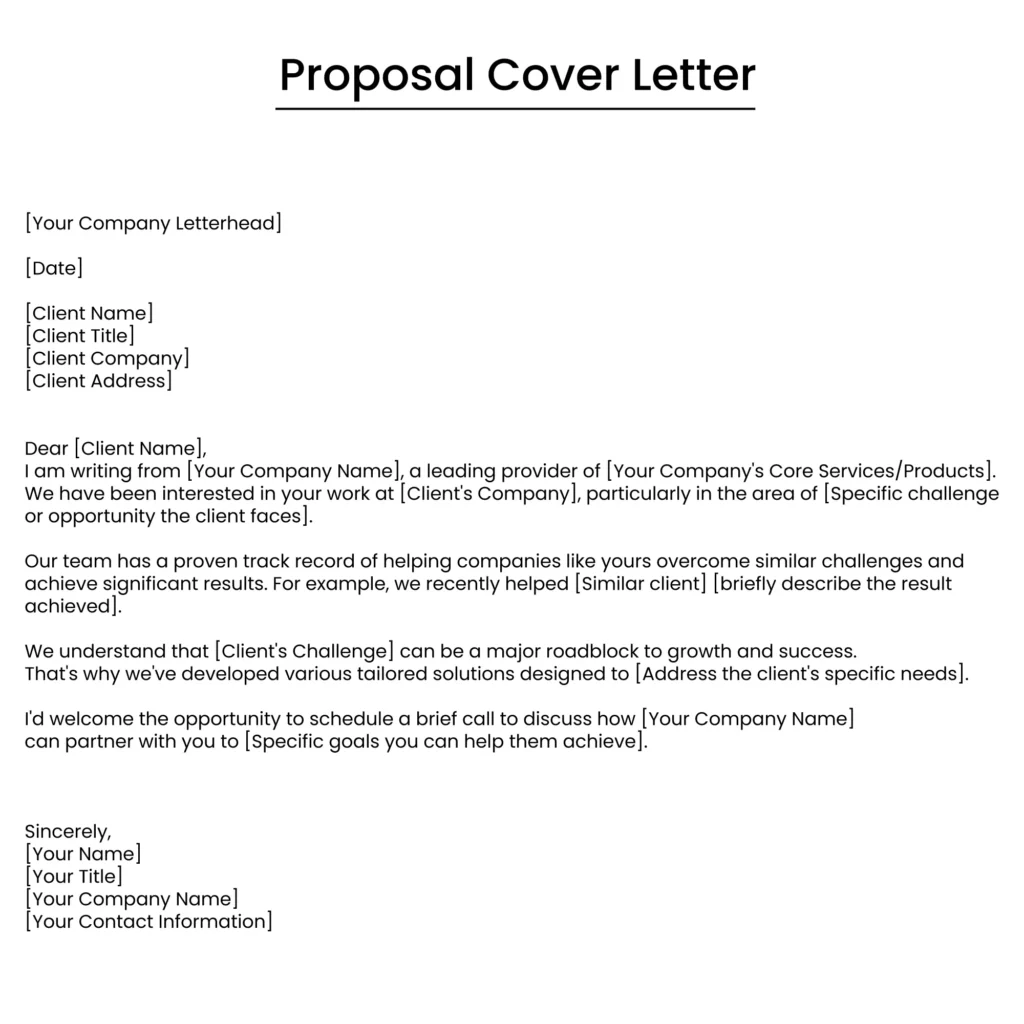
Cover Letter Template 2
[Your Company Letterhead]
[Client Name] [Client Title] [Client Company] [Client Address]
Dear [Client Name], On behalf of [Your Organization Name], a leader in [Your Industry/Field], I am writing to express our keen interest in collaborating on [Client’s Project/Goal]. We have been following your work closely and are consistently impressed by your commitment to innovation.
Our team specializes in [Your Unique Solutions/Services] and has a proven track record of delivering cutting-edge solutions that exceed expectations. We believe our expertise in [Specific Skills/Areas] aligns perfectly with your needs and can bring fresh perspectives to your project.
We are excited to discuss how our innovative approach can help you achieve [Client’s Specific Outcomes].
Thank you, [Your Name] [Your Title] [Your Company Name] [Your Contact Information]
Cover Letter Template 3
Dear [Client Name],
At [Your Organization Name], we put our clients at the heart of everything. We understand that every business has unique needs and pride ourselves on tailoring our solutions to fit yours.
We have taken the time to thoroughly research your organization and believe our [Your Services/Products] can address your specific [Client’s Pain Points/Challenges].
We are eager to listen to your goals and develop a collaborative strategy that delivers results.
Cover Letter Template 4
[Your Organization Name] is excited about partnering with you to achieve [Client’s Key Goal or Objective]. With [Number] years of experience in [Your Field], we’ve honed our expertise in [Specific Area of Expertise] to consistently deliver exceptional results for clients in [Client’s Industry].
We understand the unique challenges you face in [Client’s Specific Challenge or Pain Point] and believe our proven solutions can significantly impact your bottom line. In our attached proposal, you’ll find detailed case studies showcasing how we’ve helped clients like yours achieve [Measurable Results: Increased Revenue, Reduced Costs, etc.].
We are confident that our team’s deep industry knowledge and innovative approach can provide you with the tailored solutions you need to reach your goals.
We look forward to discussing your specific needs and exploring how we can work together to drive your success.
Super Proposal Templates
Marketing proposal.

Architectural Proposal

Branding and Identity Proposal

DVR System Proposal

Now you can become a pro in writing a proposal cover letter. It’s your key to closing more deals and making lasting relationships. But is this all? Are you ready to take your proposal game to the next level?
Give Super Proposal a try and see the difference our predefined templates make. Begin your day free trial today, and let us help you build great cover letters to close deals.
Proposal Cover Letter FAQs
What should i include in a proposal writer cover letter.
You can mention past experiences with writing winning proposals, different formats of proposals like RFP responses, and how you customize the content for each client. Let them know about your strong writing, editing, and communication skills.
How Long Should Proposal Writers Make Their Cover Letter?
The proposal cover letter should be concise and straightforward. It should not exceed one page, should highlight the client’s pain points, and should focus on your solutions.
How do you write a cover letter for Proposal Writer with no experience?
To write a cover letter without experience, you should focus on your transferable skills in writing, editing, research, and project management. Also, express your interest in that particular project and focus on your strengths and how you can deliver the client’s goals.
Are cover letters and proposals the same?
No, the cover letter is a short introduction to your proposal. It needs to highlight the key points and benefits. The proposal is a detailed document giving step-by-step detail of your solution and approach.
Read more: How to start a business proposal introduction
Read more: How to write a technical proposal
Increase your close rates today!
Secure every pitch that you make with Super Proposal. Craft winning proposals, share and track them on a single, comprehensive platform.
✓ 15-Day Trial. No Credit Card Required.
Recent Post

Vibhav Singh
Leave a reply cancel reply.
Your email address will not be published. Required fields are marked *
Save my name, email, and website in this browser for the next time I comment.
This website stores cookies on your computer. Cookie Policy
How To Write a Killer Proposal Cover Letter
In general, the three pieces of your proposal that will be read and examined properly are:
- Cover letter / Introduction / Executive Summary
This isn’t a guess. Hundreds of thousands of proposals have been sent using our software Better Proposals and we’re able to pull together statistics from that. We’ve learned that most of the time people spend on a proposal is in those three areas.

This is the meat of your proposals and the content your customer is most interested in. Make their agreement process easy by spending some extra time on these sections.
Of course, when using Better Proposals, the extra time isn't a lot since we speed up your proposal process and give you more time to spend on the creative process.
Digging Deep
That said, the most important thing to include in your proposal letter is that you understand the reader's needs and long-term goals.
This extends beyond simply telling them that they want a quote on a [fill in the blank].
In your meeting with the prospect, you should be digging deep into why they really want it. What are the underlying reasons behind it?
I've spoken about this in this video detailing why most people write their introduction or cover letter wrong.
Try to understand the benefits they expect you to bring them, their budget and whether they have some examples for the solution they want you to provide.
You should know all of this before you even start writing your proposed solution.
Let's look at an example
Your client might say “we need a new website because ours is outdated”. Okay, but what will an up-to-date one do? “Bring us more leads”. Okay, so what you really want is more leads.
You see? And you can go far deeper.
“What’s wrong with the number of leads you’re getting at the moment?” “Why is that even a problem?”
What you might find is that they’re scared their new competition across the road is going to put them out of business in a year if they don’t act fast. Now you have the information you need.
At this point, your proposal letter is about addressing the REAL fears, situations and options rather than at just a surface level.
Clients love to hear their own words in your proposal letter. It gives them confidence in their choice and shows them that you listened.
Now, the rest of your proposal is going to contain details about your plan, your pricing, why you’re different and your case studies. That's what all the best proposal examples include.
If your proposal letter addresses their real issues then you can guarantee that it's going to be read cover to cover.
What is a cover letter?
In the world of business proposals, a cover letter is the initial part of your proposal where you explain that you know the client’s situation and you know exactly how to solve their problem.
The best proposal letters I’ve seen weren’t written with amazing language. What made them stand out is that the person writing them listened carefully to the client before sitting down and writing the proposal letter.
They highlight how their process will help the client achieve their long-term goals.

My advice is to use simple language all through your document. Avoid technical jargon and make sure that the client understands everything that is being said.
After all, they will have less technical knowledge than you and also, people tend to mistrust things they can't understand.
Why do you need a cover letter?
Simply put, the client reading the business proposal needs to get engaged to read the whole thing before signing.
You could just give them a detailed specification right from the bat, but that will make the client too focused on numbers and specific results.
The proposal letter shows them that you’re listening and it gets them “hooked” to start reading.
After they’re done with the cover letter, they can move on to the more technical bits in the detailed specification.
Make sure to keep your proposal letter short, not longer than one page. You should keep your client in mind when you write a proposal letter. Don't expect them to give you too much of their time.
The connection between a cover letter and a business proposal?
In general, the cover letter is the part that comes before the actual business proposal. Sometimes, this is called a cover letter but we prefer calling it the introduction.
In other words, the cover letter is the first and perhaps the most important element of a business proposal.
Every good business proposal needs to have an introduction. We talk about introductions quite often in our articles, but don’t get confused - it’s the same thing as a cover letter.
The elements of a business cover letter
There are several things that every great cover letter needs. Here are a few to get you started:
- You need to talk about the client - not yourself. Don’t brag about your projects, awards, portfolio, etc.
- Talk “back” at the client - use their own words and expressions from your meetings and discovery calls
- Don’t get too technical - leave that for the next section
- Keep it short and to the point - the aim is to get clients to read through to the end and sign.
When addressing the problem at hand, don't place the blame on your potential client. They know that there is an issue that needs fixing and that's why they asked you for a business proposal.
You're here to fix the issue, not dwell on it. Keep your introduction positive and set your client up for a good reading experience.
The cover letter structure

While the content of your proposal will depend on the offer and your industry, the proposal letter should always follow this guide.
Opening sentence
This is the most important part of your proposal. I personally prefer to hit them on the head with a sledgehammer and get right to the point.
Shock them into reading on and learning more. Here's an example using a website design quote:
“You’re busy so I’ll get to the point. The purpose of your new website is to generate enough leads to give your sales team such an easy job they crush your competition without even trying. I’m aware that sounds obnoxious but the rest of this document will explain where that confidence comes from. The website is a means to an end. Anyone can make you a new website but what you’re after isn’t just a pretty picture. You need results and that’s what we do. We’re a results based company and ultimately so are you.”
You're saying something strange. You're suggesting that the website isn't important - that's supposed to be your core skill (in this example), but what happens when you do this is you come across like you're telling them something they shouldn't know.
Like it's a secret.
What happens when someone tells you a secret? You trust them.
Vibe of the letter
The vibe should be direct and void of any indecision. Nothing breaks trust faster than indecision.
This is why it's so vital that you get the information you need beforehand so you're not writing with 'maybes', 'sometimes' and 'ifs' in your voice.
Be sure about what you're saying.
You are the expert. Write like one.
Another mistake that people often make is focusing too much on themselves in the proposal letter. Your client doesn't care about your accolades and what inspired you to go into your line of work.
Think about it like this. If you reach out to a cleaning agency, you would want to receive a proposal that outlines their services and prices.
You're not looking forward to reading a proposal letter that explains how the owner got their passion for cleaning.
The clients want to read about how you'll help them reach their goals and what your next steps are.
When you're closing your proposal's cover letter , always invite them to read the rest of the proposal.
Without fear of it sounding generic, I always like to see people pointing their readers in the way of the case study they've included. It proves that you are the perfect company for the job .
It's a nice lead-on.
Proposal letter template
Now that you know exactly what to write in your executive summary, let's see it in action in this proposal letter example.
When you use Better Proposals to create and send business proposals, you severely speed up the whole process.
Since all of our documents are web-based, they get sent as secure links to your clients. Once they open the business proposal, they get treated to a beautifully designed cover page.
It helps you give a good first impression.
After the cover page, your client will open the introduction page. If you received a formal request for proposal (RFP), you'll know exactly who to address.

Once you do that, highlight your reason for sending the proposal - i.e. the problem at hand and your solution for it.
As you can see in our proposal letter template, you should keep it brief and get straight to your points.

Since you won them over with a great first paragraph, you can continue your proposal introduction by addressing the process you plan on using.
After you write a proposal letter once, you'll see how easy it can be when utilizing our software and educational materials. You can find the right proposal letter template and customize it to your needs.
Cover letters set the tone for the rest of your business proposal, so make sure you do a good job and don't ruin your chances of gaining a new opportunity to work.
Common proposal introduction mistakes
The elements that affect your executive summary are:
- your industry
- whether a client issued a formal request for a proposal
- does your proposal include a contract
The industry
Your industry will dictate the tone of the proposal, as well as specific details in your executive summary. If you're selling software, you need to explain how you'll research the market and find ut the targeted audience.
Don't expect the prospect to know every intricate thing about your industry. You need to find the right balance for the amount of information you'll share.
If the person you're sending the proposal to didn't request it, you need to address the reason for contacting them straight from the beginning. It would be a good idea to address the value, cost and timescales.
You could also sign your proposal letter in order to make it more personal.
Proposal software
When you're using proposal software, you don't want the client to print out your document. Because you want them to read the proposal online and utilize the digital signature option in order to speed up the sales process.
If you want to make sure your recipient is reading your proposal on a screen, keep it in mind when creating the proposal letter. It should be easy to get through, meaning you should break up your text with visuals.

Furthermore, printing can affect the conversion rate of your proposal. Our research shows that printing decreases your conversion chances by 88%.
What to include in the rest of the proposal?
Once you write a great introduction, you need to focus on the rest of your business proposal.
If you want to win clients' hearts and create a winning proposal, we suggest focusing on benefits, showing the value of your products and services and knowing the clients' budget.
We suggest you start by reading our guide on proposal writing. It will give you great insight into how to win new business.

Utilize our ideas in order to create professional-looking proposals that will help you win the job and achieve success.
Our guide includes proposal details that will help you set yourself apart from the competition and give you ideas on bettering your business proposals. The more professional your sales documents are, the easier you'll sell your solution.
Extra tip
Make sure to use proposal AI, which will give you actionable tips on how to improve your business proposal. It works by comparing your documents to other successfully sent proposals from our platform.
Writing a great proposal letter is one of the most important skills that you can have as a salesperson or business owner.
If you can do this effectively then you simply increase your sales and win better jobs, more often and at a higher price point. The more professional your business proposal is, the better your chances of winning over a client's heart are.
There are some great examples in the Example Proposal Templates section of our site. I encourage you to take a look and crib from them what you like.

If you like what you see, sign up for a free trial and streamline your sales process.

How We Redesigned the Better Proposals Website and Product in 21 Days
For a while now we've felt like the Better Proposals website and system could do with a little love. A spruce up here and there, tidying things up, removing old stuff - a spring clean as such
Proposal Software: A Comparison of the Top 10
Looking for proposal software? Check out the top 10 options with a breakdown of features, pricing and review insights.
- IT/Operations
- Professional Services & Consulting
- IT and Software Solutions
- Facilities & Maintenance
- Infrastructure & Construction
Want help from the experts?
We offer bespoke training and custom template design to get you up and running faster.
- Books & Guides
- Knowledge Base
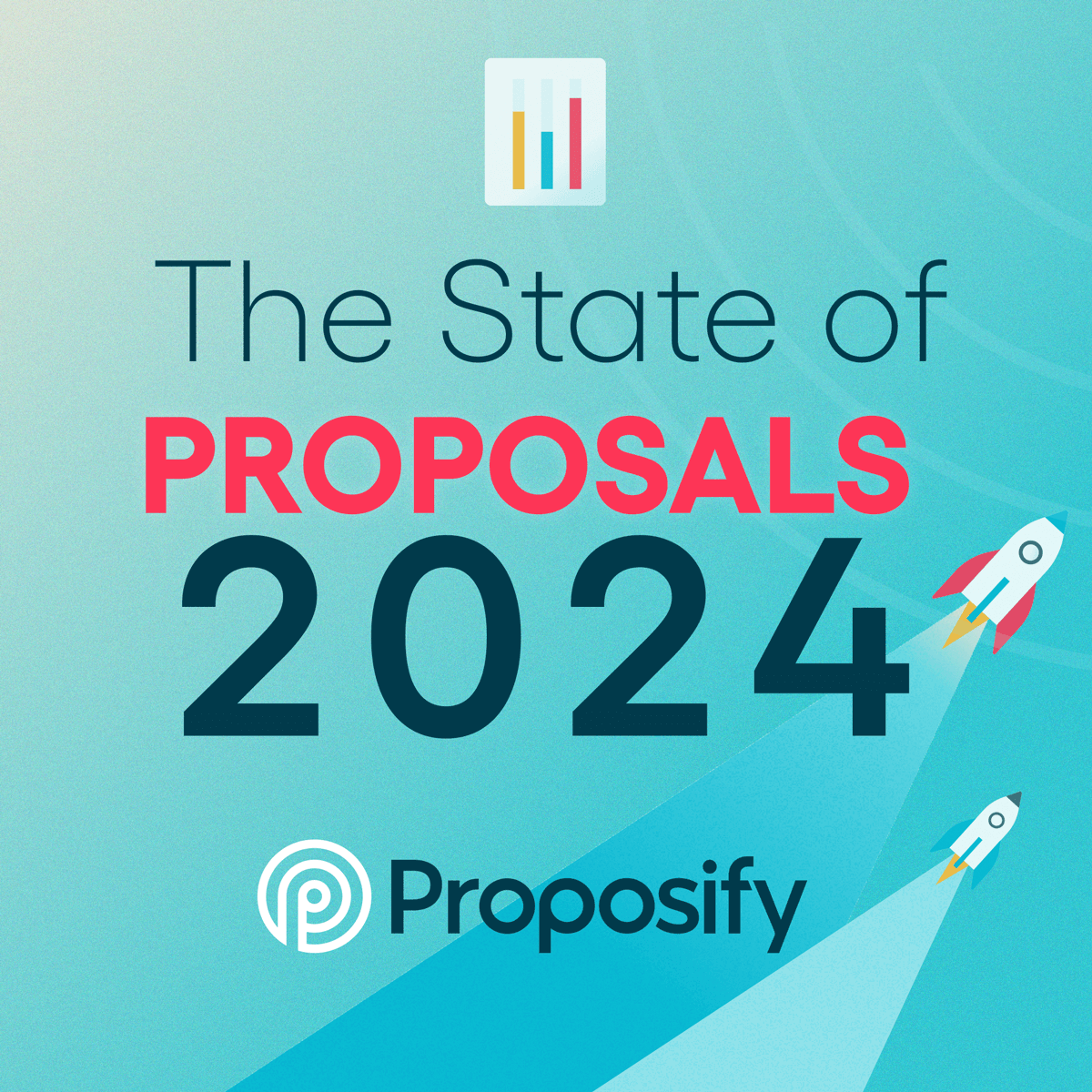
State of Proposals 2024 Report
We’ve dug deep into our data and extracted the information that sales and marketing leaders can use to make their proposals better and boost their business.
- Book a demo
- Sign Up Free
- Product Announcements
How to Write a Proposal Letter for Any Use Case [+ Templates]

Whether you’re writing a business proposal, project quote, or sales pitch, you’re going to need a top-notch proposal letter.
This letter provides context to the recipient, sets the tone and style for the proposal, and encourages the recipient to review your complete proposal.
But…writing is hard work!
To make things easier, we’ve got a simple 5-step process to help you craft your letter.
Below, you’ll also find 3 unique templates with an example proposal letter for each.
What is a proposal letter?
A proposal letter is designed to entice the recipient to read your proposal in its entirety. It can be formal or informal, and usually covers the problem statement, goals, proposed solution, and next steps. It might also include details about the project budget or timeline.
Cover letters are sent alongside all types of proposals, including:
Sales proposals
Business plans
Business partnership agreements
RFP responses
Project or service renewal proposals
Internal collaboration and project proposals
Grant proposals
Research proposals
Sponsorship proposals
Why you need a proposal letter
Here are important reasons why you shouldn’t skip the letter:
Set the tone - Your proposal letter will set the stage for the proposal. It can hint at the results the prospective client will receive or it could cover the RFP requirements that were met.
Provide context - A proposal letter provides context for why the proposal is being sent. This is useful whether the proposal was solicited or unsolicited because you give the reader a reason for being in their inbox.
Highlight key areas of the proposal - You can use the letter to surface any detail you want, be it a testimonial, average client result, low-price promotion, market opportunity, or whatever will excite your reader the most.
Encourage the recipient to read the proposal in full - At the end of the day, a great proposal letter should serve as a gateway. It gives enough information to convince the reader to give you their undivided attention and review the entire proposal.
5 steps for writing a proposal letter
Use these 5 simple steps to craft the perfect proposal cover letter.
For best results, you should write your proposal before you write the letter. This way, you’ll have already done your research on the potential project, client, or business idea.
1. Know your goals
Before you start writing, take a step back and really consider what you’re trying to achieve. Are you trying to get the attention of a prospective customer who you know will be a hard sell? Do you need to show the reader that you’ve adhered to strict guidelines that were outlined in a governmental RFP? Or, are you simply giving the person a heads-up that the proposal is ready for review?
Knowing your goals will ensure you make the right decisions in Steps 2, 3, and 4 below.
2. Determine the format and formality level
Next, it’s important to choose the right format and style for your letter.
In this digital world, written or printed proposal letters are very old-fashioned. You’re better off using proposal software , which allows you to store email templates, proposal templates, customize things as needed, automatically notify and remind recipients to sign your proposal, track views, and more.
As for style, make sure to write in your brand voice . The formality of your writing style should also match your industry and the recipient’s expectations.
In most business scenarios, the longer and more complex and more formal your proposal, the longer and more complex and more formal your proposal letter will be too.
3. Start with a template or example
The next step is to find a template or letter example that will help guide your writing process. This is especially helpful if you’re sending a proposal letter for the first time and aren’t sure of exactly what to include.
Below these steps, you’ll find 3 proposal letter templates for different use cases and an example letter for each.
Of course, you can also head over to Google images and search for the exact type of proposal letter you’re writing in order to find tons of examples.

4. Craft the letter
Now it’s time to write!
Most proposal letters should hit on all of these points (in order):
Greeting for the recipient
Statement of gratitude or excitement for sharing the proposal
The client or project problem and goals
Your proposed solution and key details
Why your company is a fit to help
Your signature
As you’re writing, do your best to match the style and tone you’ve chosen, but you can always tweak it to perfection as you edit.
5. Proofread before you send
The proposal letter is your first impression. Get it right, and there’s a good chance the recipient will read your proposal. Get it wrong, and they might never even open your proposal. This is why you shouldn’t rush. Proofread your proposal letter 2 - 3 times, and on different days if your deadline allows.
Now it’s onto the templates and proposal letter examples!
Proposal letter template #1 (Sales pitch)
While there are many different types of proposals, sales pitches are probably the most common type. Account managers or executives send proposals to prospective clients and customers in order to pitch services, software, and other solutions. Use this template to help you craft the perfect letter to go along with your proposal.
Template #1
[Your first and last name]
[Company or organization name]
[Recipient's name]
[Recipient's company]
[Hi or Dear (recipient’s first name),]
[Use the first sentence to share your gratitude and or excitement for the opportunity to submit a proposal.]
[Define the potential client’s core problem and goals in one to three sentences.]
[Describe your proposed solution and why you’ve chosen this approach in one to three sentences.]
[Use one sentence to clarify the price of the proposed solution, or if you prefer to keep the price out of the letter, list specific deliverables or timelines instead.]
[In one to two sentences, describe why your company is the best fit for implementing the solution or how you’ve completed similar projects.]
[Tell the prospective client the next steps to take, such as reading and signing the proposal.]
[Your sign-off and signature]
Jane Doe Ace Software Hi Alex, Thank you for the opportunity to share this proposal with you. Your small but mighty marketing team is struggling to release content quickly, given their limited capacity. Things are getting stuck in the review column for too long, and classic project management software means that your team is constantly searching for assets, copying and pasting content, and failing to meet campaign deadlines. Ace Software can help you achieve your goal of hitting your campaign targets and drastically improving your team’s productivity. I recommend our Premium subscription and our Platinum implementation add-on. With a one-time setup fee of $5,000 and an annual fee of $4,000, your team will be able to produce and release content more quickly—as if you had hired two marketing assistants. Ace Software has supercharged 320 content teams, delivering an average ROI of 600%. Please read through the proposal and sign off when you’re ready. Or, let me know if you have any questions on what’s included. We look forward to working with you! Jane Doe Account Executive Ace Software
Proposal letter template #2 (Project quote)
When submitting a proposal or quote for a large project , you’ll likely need to take a more formal approach with your proposal letter. This template and example are perfect if you’re responding to an RFP for a government agency or other organization.
Template #2
[Hi or Dear (recipient’s first and last name,)]
[In the first paragraph, clarify why you are submitting a proposal and to whom. Typically you will mention the entity that sent out an RFP and the title, topic, or number of the RFP.]
[Describe the core contents and requirements of the RFP in three to five sentences.]
[Describe the scope of services outlined in your proposal in three to five sentences.]
[Offer the proposed project price and timeline in one to two sentences.]
[Clarify who the recipient should contact for questions or requests for proposal revisions.]
Jane Doe Ace Construction July 13, 2023 Alex Ross, Senior Civil Engineer Anywhere, California Dear Mr. Alex Ross, Thank you for the opportunity to submit this proposal. Ace Construction is responding to the RFP for playground and park construction for Sunny Park requested by the City of Anywhere, California. The Sunny Park RFP requests submissions from contractors experienced in park construction, playground design and construction, hardscaping, and landscaping. The RFP requires an active CSLB license and compliance with the allotted budget. Our proposal is fully compliant with all aspects of the Sunny Park RFP. We are proposing the construction of three shaded picnic areas, two playgrounds for children of different ages (12 months to 4 years and 5 to 12 years), a playing field for a variety of informal family sports, hardscaping with locally-sourced materials, and landscaping featuring drought-tolerant plants. The estimated project price for all of the design and construction outlined in our proposal is $900,000, and we expect to deliver the completed project in three phases so that new park features are available for public use as soon as possible. Should you have any questions about the contents of this proposal, please contact me directly. Thank you for your consideration, Jane Doe Business Operations Manager, Ace Construction (555) 555-1234
Proposal letter template #3 (Business partnership)
When you’re writing a letter to present a proposal for a business partnership , the level of formality will depend a lot on the person or entity you’re pitching to, and how well you know them. Whether formal or informal, the following template will help you cover your bases.
Keep in mind that this template can be easily modified to fit internal project proposals and business plans.
Template #3
[Your first and last full name]
[Kickstart your proposal letter with a one-sentence description of why you’re excited about the potential of working with the other person or why you think they’ll be interested in the opportunity.]
[Describe the market opportunity, target audience, and competitive gap analysis in two to four sentences.]
[Describe how your company will compete to win in two to four sentences.]
[Describe the type of partnership you’re proposing in one sentence (general partnership, limited partnership, etc.)]
[Clarify the next steps you’d like the recipient to take, such as reading and signing the proposal or scheduling a call with you to go over any questions.]
Jane Doe Ace Startup Hi Alex, I’m so excited to send you this business partnership proposal, because I know this industry is right up your alley. With your experience and my audience, I believe we’ll be able to do great things together. The direct-to-consumer vegan frozen foods market is full of expensive products that cost $8 to $11 per serving and are consistently described as “not filling” in reviews. It’s no wonder: 400 calories isn’t enough for dinner. Based on my research, I believe that we can satisfy the needs (and stomachs) of busy vegans by providing quick-cook products with recipe options that can be easily combined with fresh ingredients on hand. This will reduce our packaging sizes, costs, and shipping costs, while making it easy for consumers to adjust the recipes to their own tastes and typical portion sizes. I propose a general partnership, where we invest equal amounts of time and money, and share the potential gains or losses equally as well. Please review this proposal in full, and let’s schedule a time next week to go over all of the details. Best, Jane Doe
Write with your unique brand voice and the appropriate formality. Encourage the recipient to read the proposal and clarify the next steps you want them to take. Get these things right, and you’ll close that proposal in no time.

Dayana Mayfield is a B2B SaaS copywriter who believes in the power of content marketing and a good smoothie. She lives in Northern California. Connect with her on LinkedIn here: linkedin.com/in/dayanamayfield/
Subscribe via Email
Related posts.
![cover letter of proposal 5 Simple Steps to Writing a Better Proposal Cover Letter [+ Examples]](https://www.proposify.com/hs-fs/hubfs/Imported_Blog_Media/blog-2019-10-29-proposal_cover_letter_samples-3.png?width=450&height=250&name=blog-2019-10-29-proposal_cover_letter_samples-3.png)
| All accounts allow unlimited templates. | |||
| Create and share templates, sections, and images that can be pulled into documents. | |||
| Images can be uploaded directly, videos can be embedded from external sources like YouTube, Vidyard, and Wistia | |||
| You can map your domain so prospects visit something like proposals.yourdomain.com and don't see "proposify" in the URL | |||
| Basic | Team | Business | |
| All plans allow you to get documents legally e-signed | |||
| Allow prospects to alter the quantity or optional add-ons | |||
| Capture information from prospects by adding form inputs to your documents. | |||
| Basic | Team | Business | |
| Get notified by email and see when prospects are viewing your document. | |||
| Generate a PDF from any document that matches the digital version. | |||
| Get a full exportable table of all your documents with filtering. | |||
| Basic | Team | Business | |
| Connect your Stripe account and get paid in full or partially when your proposal gets signed. | |||
| Create your own fields you can use internally that get replaced in custom variables within a document. | |||
| All integrations except for Salesforce. | |||
| You can automatically remind prospects who haven't yet opened your document in daily intervals. | |||
| Lock down what users can and can't do by role. Pages and individual page elements can be locked. | |||
| Create conditions that if met will trigger an approval from a manager (by deal size and discount size). | |||
| Use our managed package and optionally SSO so reps work right within Salesforce | |||
| Our SSO works with identity providers like Salesforce, Okta, and Azure | |||
| Great for multi-unit businesses like franchises. Enables businesses to have completely separate instances that admins can manage. | |||
| Basic | Team | Business | |
| Our team is here to provide their fabulous support Monday - Thursday 8 AM - 8 PM EST and on Fridays 8 AM - 4 PM EST. | |||
| Sometimes the written word isn't enough and our team will hop on a call to show you how to accomplish something in Proposify. | |||
| Your own dedicated CSM who will onboard you and meet with you periodically to ensure you're getting maximum value from Proposify. | |||
| We'll design your custom template that is built with Proposify best-practices and train your team on your desired workflow. | |||
| Our team of experts can perform advanced troubleshooting and even set up zaps and automations to get the job done. |
Subscribe via email
- Try for Free
How to Write a Proposal Cover Letter
Do you want to make a good first impression with your business proposals? If that’s the case, you cannot neglect your proposal cover letter. The success of your business proposals relies solely on how much attention you pay to every detail and how much effort you put into drafting it.
One key to drawing the attention of readers is to write a high-quality online proposal cover letter. If you are the one in charge of proposals, then you must learn how to make them as enticing and interesting as possible.
In this article, we will teach you how to create quality proposal cover letters and we will also tell you why using our software can help. So, keep on reading.
What Is a Cover Letter?
As you may know, a business proposal has multiple parts, respectively:
- Cover letter
- Executive summary
- The background of the company
- An assessment of the needs
- The goals of the project
- Plan of implementation
- A breakdown of the costs and budget
- Plan of evaluation
- Project sustainability
The cover letter of a business proposal is the part that acts as an introduction. It summarizes the most important details of your business proposal, proving to your clients that you are aware of their issues and that you have the right solution for them. In other words, it will present your client with your business offerings and why they matter.
The cover letter should also be good enough to convince your client to continue reading the proposal document. As you already know, first impressions matter. So, without putting effort and hard work into creating a fantastic cover letter for the business proposal, you are unlikely to persuade the client into reading more.
If you take a look at a proposal introduction letter sample, you will notice that what makes it so great is the attention to the client’s desires. Before writing any proposal application letter, you must listen to the customer and understand their needs.
Writing a cover letter for a proposal doesn’t have to involve complicated language. You can go for simple wording without getting too technical. The goal is to make the client understand what you are trying to communicate.
Why Do You Need a Cover Letter?
Before you check for proposal templates to draft your document, let’s see why you need a cover letter, to begin with.
Just like you, your clients are busy individuals. If you make them read tens of pages generated by an online proposal software, they are likely to run for the hills. They must know what they are getting into, and you should help them understand that the proposal is beneficial to them.
So, whether you use a proposal online software or not, you should always create a cover letter. It is your chance to make a good first impression and convince the reader that not only do you understand their problems, but you also have the right solutions for them. This way, they will keep on reading the full document.
The proposal cover letter allows you to be more personal and empathize with your clients. Meanwhile, business proposals are more factual. What better way to establish an emotional bond with your clients if not by relating to them on a more personal level?
Once you get clients hooked on the cover letter, they will most definitely be ready to proceed with the rest of the business proposal. They will go deeper into the technical specification of the process.
With good proposal letters, you can gain new clients without spending too much money. This can be a great benefit when you are just getting started with your business and don’t have a huge budget to spend on client acquisition.
With your proposal program of choice, you should ensure the cover letter is straight to the point. While you may be tempted to create a long and compelling proposal cover letter on your online proposals software, you will have better chances of success if you keep it short.
Clients are more likely to be attracted to brief proposal cover letters that don’t take too much of their precious time. So, if possible, check out some proposal cover examples before writing yours.
The Connection Between a Cover Letter and a Business Proposal
As already mentioned, cover letters are placed before your business proposal. More specifically, they are the introduction to your business proposal, making them the most relevant part of the document.
You cannot jump straight into a business proposal without introducing its contents first. This is why cover letters are so important – they provide your clients with some details about what is inside the document.
“Cover letter” and “introduction” are used interchangeably sometimes because these two terms refer to the same thing when it comes to business proposals. You might want to check out a sample proposal cover letter to prospect before drafting your very first cover.
Elements of a Business Cover Letter
Before you learn how to make a cover letter for a proposal, you must find out what the document includes. Here are the different elements of a proposal cover letter:
- The cover letter must be very short and concise, without dragging on. Clients will want to get a quick insight into the business proposal, not spend hours reading an introduction.
- The language should be simple, without technical and complicated terminology. The business proposal will take care of the technical side.
- Refrain from bragging about your business and all of its accomplishments. The focus should be on the client.
- Use some of the expressions and words from the communications you have already had with the client.
A great tip would also be to not blame the client for their issues. Your purpose is to present a business proposal that can help find a solution for that problem, not put the blame on the potential client and make them feel bad.
Cover Letter Structure
So, are you ready to find out how to write a cover letter for business proposal?
Before you start drafting your cover letter, you should ask a few questions that will help you during the writing process. For instance, you should find out:
· What is the source of the funding for the project?
· What reason does the client have behind this project?
· What would the client relate to the most?
· What is the final result that should be achieved?
Send your client a list with all your queries. Once you understand all these problems and find the right answers, you are ready to proceed.
Here is a general structure that most cover letters should follow:
1. The opening sentence First things first, you should open your proposal cover letter with the right question. You can begin by addressing the client’s problem right away so that you don’t waste any precious time. Then, follow it with the solutions you have for said issue. Another great method would be to get straight to the point. This is guaranteed to keep your clients engaged and make them interested in your offer. These solutions are their ultimate goal so give them what they want.
2. Keeping the right tone You are the expert, so you should sound like one. Therefore, you cannot afford to use a confused tone when writing the cover letter – you must be 100% sure about every detail you include there and back everything up with arguments.
In this case, it would be extremely helpful to get all the information you need before the drafting process even begins. Otherwise, you risk failing to gain the client’s trust.
Once again, you should focus on the client, not on your business and all you have managed to achieve throughout the years. You will have plenty of time to prove your worth. The client’s purpose is to find something that would solve their issues. They don’t want to spend time reading about a proud business owner who puts themselves on a pedestal.
Don’t make this mistake if you don’t want your potential client to just ignore your proposal cover letter.
3. Closing the proposal cover letter Once you reach the end of the cover letter, it is time to convince them to keep reading the business proposal. This is the ultimate goal of the document handed to the client, but you must word your invitation the right way.
So, you can direct them to the case study, where they will find all the project’s details and technicalities. If you manage to convince them that you are the solution to all of their problems, you are on your way to success.
The Bottom Line As you can see, the cover letter acts as the hook of the proposal. So, you must ensure it’s as qualitative as possible. If you need some help in creating your business proposal and cover letter, you can always opt for Proposa to provide you with useful templates and features. Our site speeds up the process of creating these documents, reducing your stress and ensuring you don’t waste time.
Build digital proposals quickly and easily with Proposa. Analyze who's opening your proposals and what they're looking at. Start building proposals better, smarter, and faster.
Get Your Free Trial
Search for:
Candid Learning
Candid learning offers information and resources that are specifically designed to meet the needs of grantseekers..
Candid Learning > Resources > Knowledge base
How do I write a proposal cover letter?
The cover letter often is your proposal's first chance to connect your project with the reader's philanthropic mission. It goes on top of a proposal, but it is not the same as an executive summary, which states your proposal's key points.
At minimum, your cover letter should:
- Request your dollar amount and introduce your project in the first sentence
- Describe how your project and/or organization will further the foundation's mission
- Reference your most recent contact with the foundation
- List the proposal's contents
- Give contact details in case the funder wants additional information
- Be signed by your organization's executive director
Dive in to this topic with our self-paced course: Crafting compelling grant proposals Learn how to craft a compelling and competitive proposal.
Sample cover letters
Samples of actual cover letters are usually hard to find because the donor and applicant may be very protective of these documents. Also, they usually are very specific to the project, organization, and funder.
However, our Sample Documents section is a searchable collection of proposals, cover letters, letters of inquiry, and proposal budgets that were actually funded. Each proposal includes a critique by the decision-maker who awarded the grant.
You also might check if anyone in your professional networks would be willing to share sample proposals and cover letters.
See also our related Knowledge Base articles:
How do I write a grant proposal?
What should be included in a letter of inquiry? Where can I find samples?
More articles on proposal writing.
Have a question about this topic? Ask us!
Candid's Online Librarian service will answer your questions within two business days.
Este artículo está disponible en español
Explore resources curated by our staff for this topic:, staff-recommended websites, sample cover letters & proposals.
Nonprofit Guides has a sample proposal cover letter, letter of inquiry, proposal, budget, and other items that may be of use to grantseekers.
Sample Grant-Proposal Cover Letter
Sample cover letter that introduces a grant proposal.
How to Write an Effective Grant Proposal Cover Letter
Lists attributes and tips to write good cover letters. Includes sample cover letter.
Sample Cover Letter,Proposal,Letter Proposal
Each section includes a brief description of its purpose and what to include.
Staff-recommended books

Winning Grants Step by Step
Find: Amazon | Free eBook
Sign up for our newsletter
- Work With Me
- Education & Training
- Free Resource Library
- Contractor Application
Proposal Cover Letter: How to Write to Win
You’ve slaved over your proposal for weeks, uniting win themes , tweaking the design, checking the boxes. All that’s left is the proposal cover letter. What’s the big deal? It’s just a formality. You can copy and paste something from the last proposal, right?
It’s so easy to fall into cover letter traps – using a form letter, not treating it as a core part of your proposal – I know, I’m guilty of it too.
That’s right, I used to have a copy and paste proposal cover letter. No judgment, please.
I thought it made my life easier. One less piece to worry about, so I could put more attention into crafting an amazing business proposal. Having a form letter also meant I didn’t have to start my cover letter until an hour before production.
Oh how I cringe at those past cover letters, and the poor, doomed proposals they topped.
*Sigh.* I’ve seen the light though, and I’m going to share my three favorite tips for writing a killer proposal cover letter. I like to call them “hook”, “highlight”, and “hustle”. These three H’s have elevated my proposal cover letters, taking them from boring formality to client-hooking machines.
Your cover letter isn’t really about you.
Seriously, it’s not.
Your cover letter is about your client. The faster you can get to their problem, the better chance you give your proposal of being read.
By fast, I mean the first sentence fast.
Take a look at your last five proposal cover letters. How many of them start with something like:
[Company name] is pleased to submit this proposal for… [Company name] is a full-service, award-winning firm… For the last 20 years, [Company name] has provided excellent customer service… [Company name] has exceptional experience in projects similar to…
Oh boy. Sounds a little narcissistic doesn’t it?
Best case scenario: most of your competitors are probably stuck in a similar cover-letter loop. Worst case scenario: you’ve just relegated your proposal to the bottom of the pile.
It’s okay! With a good hook, you’ll never have to worry about hitting the bottom of the stack again.
So how do you write a killer hook?
Go straight for the metaphorical jugular, of course, and find your client’s pressure points.
Think about the biggest challenges of the project. Maybe it needs to be completed in a certain amount of time, or the budget is limited, or the last project they had isn’t quite what they wanted so this one needs to be twice as good.
Figure out the pressure point and then take it one step further. Identify the why behind the pressure point and try to present a solution right there in the first sentence.
Once you’ve made your hook about the client, you can start bragging about yourself a little bit. Keep your introduction light and concise, and let it flow into your highlights.
Here we go – your opportunity to finally talk about YOU.
Highlights make up the meat of your proposal cover letter. They respond to the client’s pressure points (identified above) in more detail, supporting the solutions you provide with your past experience.
Your highlights might be additional challenges with teased solutions, or they might be attributes and advantages your firm brings to the table to overcome the initial challenge you’ve identified in your hook.
There are a few rules I follow with my highlights.
First, your primary highlight must expand your hook! If your first point isn’t the most important one, then the hook it expands on probably isn’t the right pressure point. Don’t open with the schedule and jump into the budget, okay?
Second, keep your points concise . Open with the problem, “tease” the solution and why you’re the best choice to provide it, and move on. Don’t give it all away on the first page.
Third, three highlights are sufficient If you don’t have three points, dig deeper and see if you can find another challenge within the project. I can almost guarantee there’s a third. If there isn’t, or there’s one major challenge that you should be focusing all of your attention on, then it’s okay to keep your letter short. The client will appreciate it. If you have more than three highlights, see if any of them overlap and can be grouped together. If not, stick to the three most important points.
The problem with most cover letters is that they lack a call to action . There’s no hustle, no passion for closing the deal.
Go back to your last five cover letters again. How did you close? What was the thought you left the client with?
We look forward to working with you on this important project. We would be honored to work with you. We appreciate the opportunity to submit our qualifications.
There’s nothing wrong with these closing thoughts, but there’s also no motivation behind them. As a reviewer, all they tell me is that you’ve left the decision in my hands and you’re hoping for the best.
You open with a hook, highlight how perfect your company is for the job, and then… fall flat?
I don’t think so. Let’s add some hustle in here.
Remember your hook? You know the client’s pressure points, you know how to solve them.
Here’s the hustle secret: Close with your first step.
What’s the first big action you’ll take with the client to solve their problem?
Close your proposal cover letter by starting the project. This lets the client know you’re ready to take on their project, and you’ve thought through exactly how to implement the solutions you’ve proposed.
You don’t have to overthink this too much, either. For example, if the project has an accelerated schedule, simply acknowledging that you’ll be ready to go on day one might be enough. Your closing for that challenge might look like:
Thank you for this opportunity. We look forward to meeting with your team on September 1 to kick off the project.
Presumptuous? Maybe. Proactive? Absolutely. Sprinkle in a few details on what you’ll discuss in that meeting to achieve an accelerated schedule, and you’ve caught my interest as the client.
Hook, Highlight and Hustle Your Way to A Killer Proposal Cover Letter
Alright – now you know my secrets for writing a killer proposal cover letter. Hook, highlight, and hustle your way to more business!

Bonus: Sign up for access to my Killer Cover Letter worksheet in the FREE Resource Library !

Share with a fellow marketer:
Related Posts
Leave a comment cancel reply, ready to start writing better proposals.

- More Networks

4 Tips To Creating a Proposal Cover Letter (& Templates)

Once you've put together a proposal , it's common to think, ‘Now what?'. We're here to answer what's the best cover letter you can send with your proposal to close a deal.
Within a proposal cover letter, there are a few different components that you need to consider.
- A cover letter is more casual than an executive summary
- It's structured like a letter and has a greeting and sign off
- Not focused on strategy, but is more conversation
- Should focus on the unique strengths that you can bring to a project
In this blog, we'll be covering how a proposal's cover letter differs from a job application letter, how it's structured, and the tips that'll help you close deals.
But first, let's go over what one is and why it's so important in getting your business proposal read.
What is a cover letter?
Cover letters help you grab the potential client's attention quickly. It's a short, single-page document that includes an overview of the most critical details of your proposal. If you haven't yet written the proposal, we have a sample business proposal you can read here with some templates to help you get started.
The goal of a great cover letter is to convince the client to read the rest of your proposal, so you'll want to make the writing as interesting as possible. You can mention any critical details you think will help you land the job, including your past results, skills, and education. You should also cover the key aspects of the project you're pitching. Think of it as a stripped-down version of an executive summary.

Why is a cover letter important?
Clients can be very busy. A cover letter helps clients decide whether they're interested in reading the entire proposal. This means that having a strong cover letter is just as important as the business proposal itself.
Take this as an opportunity to give clients a great first impression. A business proposal tends to be more factual, while a cover letter has the benefit of being more personal. By sparking an emotional connection early on, you'll have a much higher chance of them reading the whole pitch.
A good proposal can also help you get your foot in the door of larger companies, even if you don't have a connection to anyone working there. Just warm up a cold pitch by attaching a cover letter to an unsolicited business proposal.
This is especially important at the beginning of your career, since you may not have the funds to reach clients through traditional marketing. Cover letters can be a powerful way to land clients without having to spend any money on new client acquisition costs.
We have some tips that'll make this process easier, but first, it's important to talk about the traditional structure of a cover letter.
How to write a proposal cover letter
Let's briefly walk through the structure, since the information you'll include will be slightly different from a traditional job application cover letter.
A proposal letter looks like this:
Contact information
Introduction.
It may seem pretty standard, but the information in a business proposal cover letter will be a bit different from other cover letters. Here's a closer look at each paragraph:
Start off by adding your name, address, phone number, and email to the header. Feel free to also include the potential client's contact information. Although it's not as important now with email as it used to be in the days of snail mail.
Pro tip: Drop a link to your LinkedIn profile in the heading too. This lets them get a better feel for who you are and can even provide them with additional information that you didn't have room to include in your cover letter.
It might be tempting to breeze through the introduction to get to the "meat" of the letter, but the introduction is actually one of the most important parts. You need to capture their attention right away, so come up with an engaging way to introduce yourself and what your business does. It's one of the few spots of a cover letter where you can inject your personality into the writing, so make it count!
This is where you'll address the company's needs and how you plan to help them. Unlike a traditional job application, a business proposal's cover letter has the intention of selling a service or product. Be sure that the writing is sharp and highly persuasive. You want to generate enough excitement that they move on to your executive summary and, ultimately, read the rest of the proposal.
You can include any core strengths and past results that have helped previous clients. However, keep this section concise by sticking to just a few of the most important details that directly apply to the client. End this section by covering how you plan to achieve the goal you're pitching. Think of this as more of an "overview" of your plan. They'll get more details when they read the rest of the proposal.
Like the introduction, it's typical to see cover letters that spend a lot more time on the body paragraphs than the closing paragraph. But leaving readers on a strong final note is just as important as making a great first impression. It's recommended that you wrap the cover letter up by mentioning a strong benefit your project will bring to the company.
The last critical piece of information you need to include is the call to action. What do you need them to do next? In this case, the next action you'll want them to take is to read the business proposal. Provide some encouraging words to move the client in that direction.
4 Tips for creating a cover letter
Now that you have the structure down, it's time to start writing it! We have some tips to elevate a cover letter so you can start closing deals.
Step 1: Kicking off the cover letter
A great cover letter starts by showing off your personality and the type of communication they can expect if they're going to work with you. Lean into your intuition and use your voice!
There's no reason to be super corporate here. Instead, show that you're a person who can be professional, but still enjoys the work you do.
Your approach will be a bit different depending on if the business proposal is solicited or unsolicited:
- Solicited proposal: If a client asked you to send a proposal, you can start by saying "As per our discussion..." before addressing their problem and your proposed solution.
- Unsolicited proposal: The first sentence is crucial. Grab their attention immediately with an engaging statistic related to their problem and how you can help them.
It's important to hook your reader right up front! That means understanding who your audience is and the industry you represent will be critical to nailing a cover letter. For instance, if you're pitching a more traditional company, like one in finance, consider how they may expect communications as opposed to a start-up.

Typically you can get a feel of how a company communicates by viewing their website, content, and related information to get a feel for their tone and voice.
Find a balance between being true to your voice and communicating in a way that's comfortable to the prospective team.
Here are a few examples of the beginning of a cover letter.
Hi Prospective Client,
Thanks for taking the time to review my proposal! I'm really excited about the ways we can work together to support [company].
Hello Mr./Mrs. prospective client,
I'm pleased to present you with the request for proposal [proposal title]. In this proposal, you'll find goals and objectives, scope of work, pricing, [and any additional information you found relevant.
You can see the difference between these two tones. Consider when would be appropriate to use either.
Step 2: Highlight what problem you'll help the company overcome
Within any proposal, you want to ensure that your client knows that you understand the problem that they're trying to solve. Include their goals and objectives of why you're entering this engagement.
Share the company's pain point in a way that's easy to digest. Leave this section to focus on the company's problem. Later, you can mention the solutions.
Here's a snippet of a type of pain point a client may be facing:
Right now you're creating a lot of excellent content and it's frustrating when it's not leading to the increase in traffic and conversions you're hoping for.
Step 3: Share how you'll work towards their goal
The next section of the cover letter will outline how you plan to approach their challenge. Now, remember, this isn't where you get into the nitty-gritty. This is just a high-level overview of your plan of attack. Specific details will be broken out in your proposal.
Here's an example of a short and efficient way of accomplishing this step.
Based on the data I've seen, I'm confident that we can make some major traction in increasing your organic traffic with your target audience with a few well-implemented strategies that I've outlined in the attached proposal.
Step 4: End your cover letter with next steps
Once you've worked through the steps of a cover letter, the last piece that you include is the next steps. Sometimes your client will already have shared their process and timelines associated, but if they haven't this is a great opportunity to take initiative and show them that you're able to make their lives easier by outlining what's needed to move forward.
Below's an example of some ideal next steps.
Once you've had a chance to review the proposal, please feel free to follow up with any questions. I'll be following up in a week to check in on the status and see if there are any additional ways to support your team.
If you decide to move forward, we can start the engagement within a week of signing the contract.
Proposal cover letter samples
Below we've compiled a couple of different examples and templates of what you can use to create a template for your client today.
Proposal cover letter sample #1
We'll kick things off by sharing full versions of the snippets we included above. This is for a proposal for SEO and content strategy to support clients looking to increase organic traffic.
Right now you're creating a lot of excellent content and it's frustrating that it's not leading to the increase of traffic and conversions you're hoping for.
Based on the data I've seen, I'm confident that we can make some major traction in increasing your organic traffic with your target audience by implementing a few strategies that I've outlined in the attached proposal.
Most Sincerely,
Proposal cover letter sample #2
In this sample, your cover letter is approached with a more formal tone and is for a client who is looking for support in their product strategy.
Hello Ms. Thompson,
I'm pleased to present you the request for Project Strategy Proposal. In this document, you'll find outlined the goals and objectives, the scope of work, pricing, and some case studies of relevant projects I've worked on.
I know that Quest Products has been struggling with converting their traffic to their Saas platform and hitting their retention goals.
After some analysis, you'll find within the proposal a scope that entails audience research, user testing, and analyzing data analytics that will all work towards the goal of boosting conversion rates and diagnosing any challenges.
Once you've had the chance to review, please let me know if you have any initial questions or concerns. I'm happy to provide any additional information that would be useful.
I'll follow up with you next week to check in and outline the next steps.
Most sincerely,
You'll see that within each example we include four key components: intro, highlighting the problem, sharing your proposed solution, and providing the next steps.
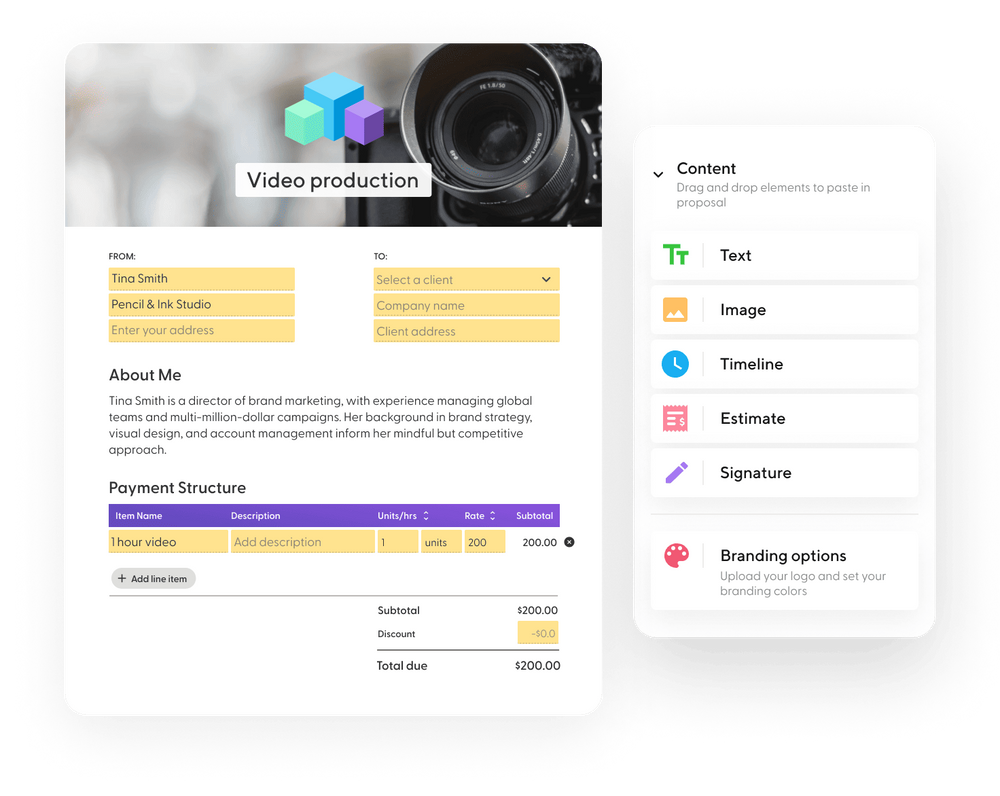
Need a proposal for a potential client?
Create a professional proposal in minutes with Indy’s Proposals tool. Use your logo and branding, add terms, and include portfolio items.
Wrapping up
A cover letter gives you the chance to point out a problem with a company and propose yourself as the perfect solution. And though it can be time-consuming, the results that a winning cover letter can bring to your business are well worth it in the end.
But if you're looking for a faster way to write business proposals, you can speed up the process by using proposal software . Just choose the template you need, fill in your details, adjust the content to your liking, add your branding, and you can be finished in minutes. As you move forward with creating a cover letter, keep in mind the tips we've outlined above and you'll be sure to succeed!

WTO / Letters and Emails / Cover Letters / Grant Proposal Cover Letter Sample: Expert Guide (Templates)
Grant Proposal Cover Letter Sample: Expert Guide (Templates)
A Grant Proposal Cover Letter is a formal document that provides information about a proposed project or mission.
It is submitted to government agencies, foundations, or organizations that provide grants.
The grant proposal cover letter is submitted with the grant proposal or application document. It provides vital information about the project, its background, purpose, and goals. The grant proposal cover letter is used to help persuade the reviewer to provide financial support for the project. The letter can be used by organizations that have written a grant proposal or application document to potential funders.
Free Downloads
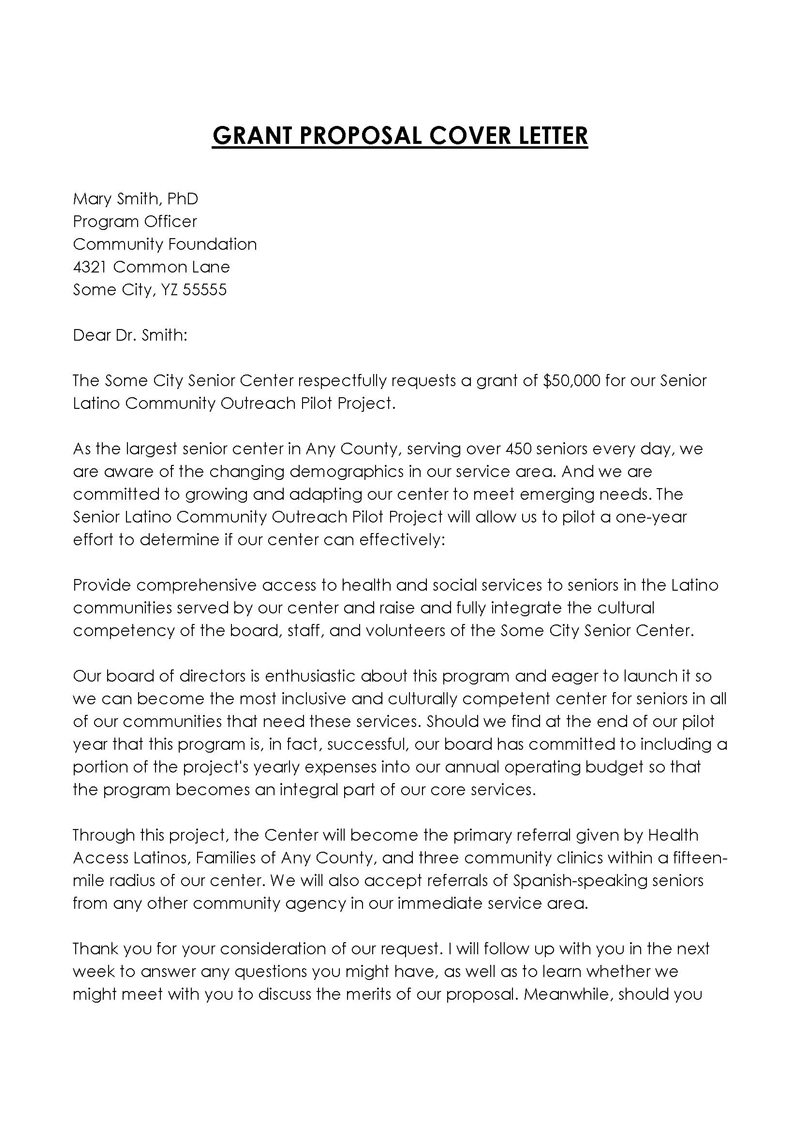
Writing a Grant Proposal Cover Letter
Organizations writing a grant proposal cover letter must ensure they follow a well-outlined process. The step-by-step process ensures that all elements of the grant proposal letter are included. It also helps ensure that the letter is written in an appropriate format.
The following is a step-by-step process of how to write a grant proposal cover letter:
The top of the grant proposal cover letter should include a letter header. The organization’s writer may opt to use a formal header to ensure the letter looks more professional. The information provided in the header will ensure that general information concerning the organization and funder is provided.
The following information should be contained in a grant proposal cover letter header:
The date indicated in the header of a grant proposal cover letter should be the same as the date stated in the complete grant application. Stating the same date on both documents means they are sent to the guarantor on the same day. It helps create consistency in all the documents.
Address the funder
The funder’s name, address, city, state, and zip code should be indicated. The funder’s details provide information on who the letter is for. The funder’s address should appear under the sender’s address. The organization’s writer should confirm the name and address of the funder with a phone call or email the funding body. It will help to ensure the funder’s details have not changed.
Your company details
At the top left of the header, the writer’s company name and address should be provided. The writer’s company details will provide the funder with information on which organization is writing the letter.
Secondly, the organization’s writer must greet the funder with ‘Dear’ and include a recipient’s title such as Mr., Ms., Dr, etc. The salutation should be followed by the funder’s name, which should be punctuated with a comma. The writer can ensure that the right person is being addressed by calling the company or organization meant to receive the letter and confirming the detail.
Introduction
Thirdly, the organization’s writer should be introduced in the grant proposal cover letter. The organization’s legal name, which is its corporate name, should be indicated. In addition, the writer should indicate what the organization does and the need for its work.
Next, the body of the grant proposal cover letter should discuss the project. The information provided in the body will enable the recipient to understand what the organization hopes to accomplish with the grant. The writer should explain what the project is, the purpose it serves, and how it aligns with the funder’s priorities.
The writer can also add any data obtained that shows why the project is necessary. The amount of money the organization requests and the reason or use for the sum should be provided.
The following information should also be outlined in the body of the grant proposal cover letter:
Explain methods, strategies, and solutions
The writer should provide information on how the organization plans to use the grant and the solutions the fund will offer to a problem. The writer can incorporate a visual representation or graphic model of this information. The methods used to represent the organization’s data should be combined with details to ensure that the grant proposal cover letter has a professional tone. The writer can mention a timeline of when the funder should expect to see results.
Explain your corporate structure
The body of the grant proposal cover letter should also contain information on the grant requesting organization’s corporate structure. The writer should indicate that the organization’s internal management structure supports the project. The information on the corporate structure should be brief.
Highlight your strengths
The writer should explain why the organization is the best place to execute the project- or mission. Comparison with other organizations can provide clarity on which areas the writer’s organization excels in. The writer may sight the experience of the organization’s staff and volunteers, experience with the problem the project hopes to resolve, or community support for the organization. The names of the other organizations used in the comparison don’t have to be mentioned. The writer’s emphasis should be placed on highlighting the organization’s strengths.
Finally, the concluding paragraph should summarize the information already stated in the grant proposal cover letter. The writer should also include a thoughtful sentiment of what partnering with the funder would mean to the project’s beneficiaries. An expression of the writer’s appreciation for the funder’s consideration of the grant proposal should be indicated. The writer can also extend an invitation for the funder to visit the organization or its worksite.
The writer should end the grant proposal cover letter by signing off with an appropriate word or phrase such as ‘Sincerely,’ an ‘awaiting your response’ or ‘With great hope.’ The sign-off word or phrase used should suit the theme or topic of the letter. The executive board of directors, board president, or both should sign the grant proposal cover letter. The sign-off should indicate the signer’s first name, middle initials, last name, and jobs title. The writer should also provide the contact details of an individual who can answer the funder’s questions.
Note: The word ‘ENCLOSURE’ or ‘ATTACHMENTS’ should be written at the bottom of the grant proposal cover letter. These words help to indicate that the grant proposal is included in the packet. Writing these words in all caps emphasizes the importance of the grant proposal.
Grant Proposal Cover Letter Template
[Organization’s Name]
[Organization’s Address]
[City, State and Zip Code]
[Funding organization’s contact Name]
[Funding Organization’s name]
Dear {funding organization’s contact Name],
[Organization name], which has been around for{number] years, is requesting a grant of ${amount]. The funds will be for an upcoming project, [project title]
Our organization focuses on [organization’s mission]. The project centers on [purpose of the project]. We target [group set to benefit from the project]. The need for the project is supported by our primary research, which found that [ the problem the project aims to solve]
The grant fund provided by your organization will enable us to [how the grant will be applied]. The fund will ensure that [ potential positive impacts provided by the funds]. Our [corporate structure] have expressed their enthusiasm for the project. We believe that our connection with [target beneficiaries] places us in the best position to carry out this project.
We appreciate your consideration. Please feel free to contact [name of organization’s contact] for any questions at [phone number or email].
[Signature]
[Name of CEO/board chair]
Sample Letter
Oracle Literacy Center
245 Hill Street
Boston, MA 46479
May 18th 2020
Neilson White
Waves Discovery foundation
Boston, MA 43578
Dear Mr. White,
The Oracle Literacy center, which has been around for 10 years, is requesting a grant of $ 500,000. The funds will be for an upcoming project, Digital Literacy Academy.
Our organization focuses on bringing literacy to disadvantaged communities in developing countries. The project centers on developing digital skills in Malawi. We target poor, disadvantaged adolescence and children. The need to implement the project is supported by our primary research, which found that less than 4% of the population has digital skills. We understand that your organization aims to increase literacy in developing nations; hence, why we believe that parting with you can help both organizations meet their goals
The grant provided by your organization will enable us to build a learning facility in the outskirts of the capital. The fund will ensure that poor, underprivileged children pioneer a new digital era in the county to facilitate its development. Our board of directors has expressed their enthusiasm for the project. Our connection with the local people places us in the best position to carry out this project.
We appreciate your consideration. For any questions, please feel free to contact James Green at 555-555-7788 or [email protected].
Mary Winters
Executive Director and Manager
Do’s and Don’ts for Writing the Letter
When writing a grant proposal cover letter, it is important to consider the dos and don’ts. Understanding the do’s and don’ts of writing a grant proposal cover letter will ensure that the organization captures the funder’s attention. It will also ensure that the letter is effective in communicating information about the organization and the grant.
The following are the does and don’ts of a grant proposal cover letter:
Following are the dos for a grant proposal cover letter:
The grant proposal cover letter should be a quick read for the funder. Therefore, the writer of the letter should ensure that it is only limited to one page. The contents of the cover letter should be focused and to the point. Each paragraph should be limited to only a few sentences to ensure that the letter is short.
Ask for feedback
Upon completion of the grant proposal cover letter, the writer should ask a co-worker to read it. The co-worker will help identify any typos in the letter. The reception of positive feedback will be an indication that the writer should send the letter. In addition, asking for feedback will help ensure that the grant proposal cover letter effectively compels the funder to consider the organization’s grant proposal.
Format the letter carefully
The writer of the grant proposal cover letter should ensure it is appropriately formatted. A well-formatted grant proposal cover letter ensures that single spacing is applied throughout the letter. There should also be spacing between the organization’s address and the funder’s address. Appropriate spacing should also be applied between paragraphs. If possible, the writer should include a live ink signature. Three blank spaces should be left where writers can indicate a complimentary close and their name for the signature.
Send the cover letter in PDF
The grant proposal cover letter should be in PDF if the writer intends on sending the letter via email. PDF will ensure that the letter is safe from malware. It also helps the foundation sign the letter digitally if it wishes to do so. Sending the cover letter in PDF will also lead the funder to perceive that the organization is competent.
Write the cover letter last
The cover letter should be written last because it helps the organization reflect on achievements such as completing the fund request. It also ensures that the writers provide information from a knowledgeable perspective. The writer also ensures that the cover letter is more engaging than the other documents attached to it.
Don’ts
Following are the don’ts for writing a grant proposal cover letter:
Don’t repeat the information in the proposal
The grant proposal cover letter should not be a repetition of the information contained in the proposal. Its main purpose is for the funder to get to know more about the organization and its project. It is a tool that can persuade the funder to provide the organization with the grant.
Don’t use big words
The writer of a grant proposal cover letter should avoid using complex words that the funder may not understand. The use of complex words could be counterproductive and jeopardize the organization’s chances of receiving the grant. Instead, the writer should only focus on pleading the organization’s case before the funder.
Don’t make grammatical mistakes
The writers should proofread the grant proposal cover letter upon completion. No grammatical mistakes should be present in the document. The presence of grammatical errors may lead to the organization being perceived as unprofessional and lazy.
Key Takeaways
- A grant proposal cover letter effectively provides information about an organization’s grant proposal and shows its commitment to the project suggested to the funder.
- The letter can achieve its effectiveness by providing clear, concise information about the project.
- The organization must ensure that it mentions certain aspects of the project, like its potential beneficiaries.
- The tone of the letter should be professional.
About This Article

Was this helpful?
Great! Tell us more about your experience
Not up to par help us fix it, keep reading.

Cover Letters , Letters and Emails
Director of development cover letter (sample – templates).

Mechanical Engineer Cover Letter Examples – Templates

Write an Entry-Level Cover Letter (Examples, Format, Tips)
![cover letter of proposal Dietary Aide Cover Letter Guide and Templates [2021]](https://www.wordtemplatesonline.net/wp-content/uploads/2021/03/Dietary-Aide-Cover-Letter-Guide-and-Templates-2021.jpg)
Dietary Aide Cover Letter Examples (What to Include)

Caregiver Cover Letter Samples [How to Write]

Cover Letter for Internship Examples – Writing Tips

Administrative Assistant Cover Letter Samples

Public Relations Cover Letter Examples (Free Templates)

Letters and Emails
Free pay for delete letter templates (8 successful examples).
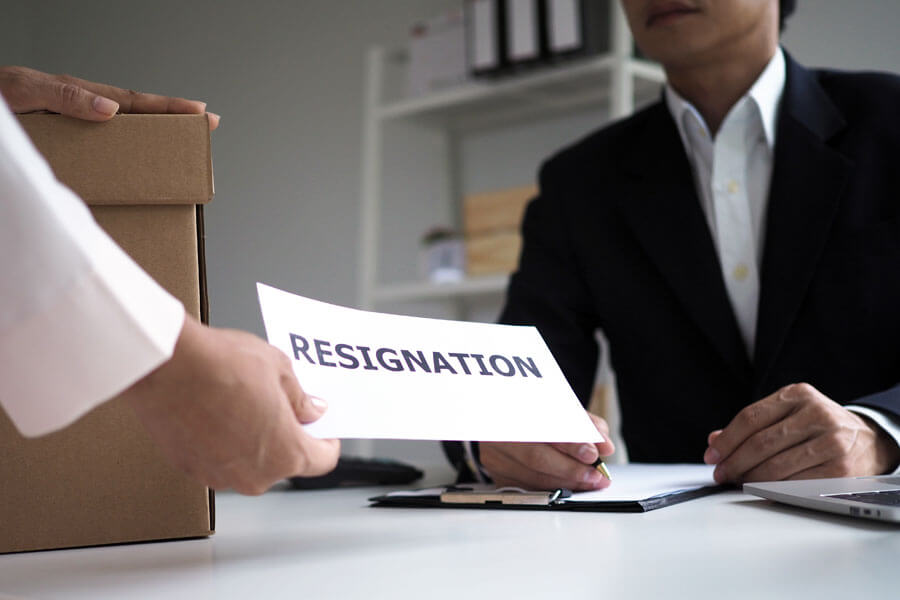
Letters and Emails , Resignation
Two weeks’ notice resignation letter (14 samples).

Sample Permission (Consent) Letters to Use School Premises

How to Reply to an Interview Invitation Email (Samples)
Thank you for your feedback.
Your Voice, Our Progress. Your feedback matters a lot to us.
Success Rates Across Different Grant Funders 📊 Which should you pursue? Access report .
How to Write a Cover Letter for Your Grant Proposal
Customer Success Manager at Instrumentl
Reviewed by:
November 20, 2023
Table of Contents
If you’re applying for a grant, the funder will often ask you to submit a cover letter with your grant proposal.
I know, this can be frustrating. You’re already dedicating time to writing a successful grant proposal . Why do you also have to write a cover letter?
Although it may seem like extra work, it’s actually a critical step to get right. If you don’t nail it, the funder may pass over your application entirely.
To avoid this, we’re going deep into how to write effective cover letters for grants. In this article, we’ll unpack:
- What cover letters for grant proposals are
- Why it is an important piece of your grant application
- And the six parts of a successful cover letter
- Templates to get you started
- Pitfalls to avoid
Let’s dive in!

What are Cover Letters for Grant Proposals?
A cover letter for a grant proposal is a document that goes along with your completed proposal. It is your opportunity to demonstrate that you understand the priorities and interests of the funder and how your work aligns with their goals.
An effective cover letter will communicate why your organization and your program deserve to be funded . It should pique the funder’s interest, getting them to read your full proposal.
Pro Tip : Cover letters are typically only requested by foundations and corporations . In the case of government grants , they don’t ask for cover letters because they have very specific proposal layouts and requirements.
Only submit a cover letter if the funder requests one. Many funders now utilize online application systems which do not require a cover letter, so make sure you understand the requirements of the specific funder.
Overall, the cover letter provides a taste of your organization and request. It should entice the funder and demonstrate why you are a good fit.

Insights Straight To Your Inbox
Why are cover letters important for nonprofits.
If you see the cover letter as just a nother checkbox you need to complete before submittign your application, think again. Here are 4 reasons why you need to think hard about writing a grant proposal cover letter that captures the attention of funders.

First Impressions Matter: Setting the Tone for Your Proposal
The cover letter is the first point of contact that your nonprofit has with a potential funder, and you want to make a good impression !
A professional, concise, well-written cover letter sets the tone with the funder for the rest of your proposal. It’s also a chance for you to capture the reader’s attention and get them excited about your proposal.
Building a Connection With Potential Funders
Your cover letter is your opportunity to get the funder engaged .
The cover letter gives you a chance to share your “elevator pitch” with the funder. If a funder walks away from your cover letter feeling excited about your project, you’re leagues ahead of the competition that submitted a dry, cookie cutter cover letter.
Highlighting Key Points From Your Grant Proposal
A grant proposal’s cover letter isn’t all that different from a potential job’s cover letter.
Highlight the key points that will help you stand out above other applicants . Don’t be afraid to brag a little bit! Tell the funder why your proposal or project is unique and impactful.
But remember—a cover letter is not an executive summary .
Demonstrating Organizational Maturity and Professionalism
Your cover letter is an opportunity to demonstrate your organization’s maturity and professionalism . Make it known that you receive and manage a large grant portfolio of grants every year, and that you have experience in maintaining grant compliance .
In doing so, you are showing the funder that they can trust you with their award.
Find Your Next Grant
17K Live Grants on Instrumentl
150+ Grants Added Weekly

6 Parts of a Successful Grant Proposal Cover Letter
Below are general formatting tips for your grant’s cover letter:
- Your cover letter should be written on company letterhead.
- The date on the cover letter should match the date of your proposal or application.
- The letter should be contained to one page, consisting of 3-4 paragraphs.
- Find the appropriate contact person at the funding organization so you can address your letter to a specific person.
- The address of the funder should be placed at the top of the letter. Format the address as: contact name, title, funder name, address.
- Use a formal introduction in the salutation, such as “Dear Mr/Mrs.”
- The letter should be signed by an appropriate official from your organization, such as the Executive Director.
- Include the word “ENCLOSURE” or “ATTACHMENT” at the bottom to indicate that the letter is part of a larger packet.
In addition to these basic formatting tips, there are 6 basic parts that you should be sure to include in your grant proposal cover letters.
Introduction: Who You Are
Be sure to introduce your organization at the beginning of your cover letter.
This provides readers with a background understanding of your nonprofit and its purpose. You want to include things such as the name of your organization, your mission and values , and how long you have been in existence.
About Your Organization: What You Do
In this section, you want to concisely explain what your organization does—include relevant programs and projects.
This will show that your organization’s work aligns with their mission and giving priorities.
Need Statement: The Problem You're Addressing
Clearly state the problem that your program or project intends to address.
This demonstrates to the reader that you are filling a gap that exists in your community. You should include data to support your statements when possible so that the funder knows the need is real.
Project Overview: Your Plan
While space is limited in a cover letter, it is important to share outline a well-thought-out project plan. Showing funders how you plan to utilize their funds will help your proposal stand out.

Funding Request: What You Need
The whole purpose of submitting a grant proposal is to secure funds for a program or project.
Don’t dance around it. Call out exactly how much money you need for your initiative so that the funder knows up front whether or not your request is in alignment with their giving priorities.
Pro tip: Often, nonprofits don’t ask for enough funding. To not leave anything on the table, Instrumentl users can quickly uncover how much to ask for in a grant by using our insights on funders.
Closing: Why They Should Support You
You want to end your cover letter by telling the funder why they should support you. Whether it is because your missions are aligned, your project is super unique (ideally, both!), you want to clearly state these reasons in your cover letter.
Consider closing the letter with an invitation for a site visit or program observation, if appropriate. Be sure to include the contact information for whoever can answer application questions. And end with a confident statement such as “I look forward to speaking with you more about this program.”

Want to get better at grants?
Get access to weekly advice and grant writing templates.

10k+ grant writers have already subscribed
3 Sample Cover Letters for Grant Proposals
In this section, we have written original sample grant proposal cover letters. Following each example, we break down the good and bad parts of each letter.
1. Following Up After Meeting With The Funder
Grant proposal cover letter example one breakdown.
Here’s why we like this cover letter:
- Referencing those prior conversations will remind the funder that you’ve already done some leg work in terms of outreach and research into the foundation.
- This letter includes erveral of the key parts of a successful cover letter, such as the introduction, information about the organization, funding request, project information, and a confident closing.
The letter is also signed by the executive director and provides her contact information. However, there could be a bit more emotion incorporated into this letter to help the funder form a connection with the organization and the project .
2. Breaking The Ice With A New Funder
Grant proposal cover letter example two breakdown.
Our second grant proposal cover letter example also covers many of the key components: organizational info, funding request, project information, and a closing.
We really like how the closing in this letter includes an invitation for the funder to tour the facility and see the work in action—this is such a good idea!
This letter is lacking a statement of need , however. Although it clearly shows alignment between the nonprofit’s work and the funder’s mission, there’s no information about why there is a need in this community for support for people suffering from PTSD . Again, some data points would go a long way here in making this a more compelling case for support.
Also note that this letter does not reference any prior conversations with the funder. This is a good template to use if you are applying to a funder for the first time.
3. Renewing Funding From A Previous Funder
Grant proposal cover letter example three breakdown.
Our final example demonstrates how you would write to a funder that has previously funded your organization.
The nonprofit explains how a prior grant from this foundation helped their program; we LOVE that they included data about how many youth were served from the prior grant. This helps the funder really understand the impact of their donation, which will give them confidence in choosing to fund this organization again.
This letter also does a great job of showing the nonprofit’s alignment with the funder’s mission and work . Again, this instills confidence in the funder that they’re making a good investment with their money.
Mistakes to Avoid When Writing a Grant Proposal Cover Letter
So, we’ve reviewed what a grant proposal cover letter is, why it is important, and what the key parts are that should be included in the letter.
You’re probably feeling like you’re almost ready to start writing your own cover letters—but hold on. Before you dive in, let’s review some common pitfalls in cover letter writing and how you can avoid making these mistakes.

Overloading the Cover Letter with Jargon
One of the biggest mistakes you can make when you’re writing a grant proposal cover letter is filling it with industry-specific jargon .
Don’t try to impress the funder with all the fancy terminology of your industry. Not all funders will understand this lingo, and it could end up confusing them instead of helping to make the case for your project.
Ignoring Specific Funder Guidelines and Requests
This is a critical mistake that many grant applicants make. Don’t ignore the funder’s guidelines !
Every funder will have different requests—whether they want you to hand-deliver 10 copies of your single-sided application or request a signature from your Board Chair, it’s imperative that you follow these guidelines.
This relates to the cover letter as well! If a funder specifically says to not include a cover letter, listen to them!
Being Vague or Generic in Your Statements
Another common pitfall that nonprofits fall into is being overly generic and vague in their cover letters .
To demonstrate why your nonprofit is a good fit for the funding opportunity, share specifics about your organization, background, mission, and goals.
Another piece of advice—don’t use the generic “To whom it may concern” or “Dear Human Resources” salutation. Find a specific contact to direct your proposal to so that you can personalize the letter.
Instrumentl is a great resource for finding funder details, providing clear insights into who some of the key people within a foundation are.
Overlooking the Importance of Follow-Up Information
All of the examples that we showed you included details on who the funder should contact if they have any questions . This is so important!
You don’t want a potential funder to be stuck Google-searching information on your nonprofit if they need to contact you. That’s a sure fire way to get your application declined.
Wrapping Things Up: Cover Letters for Grant Proposals
To conclude, make sure you understand funder requirements, obtain information for a direct contact at the funder, and write the cover letter after you complete the grant proposal application.
If you follow these steps, you will be well on your way to writing a good grant application letter.
For more tips on enhancing your grant proposals, check out these 21 grant writing examples for nonprofits !

Amelie Heurteux
Amelie Heurteux, a Customer Success Manager at Instrumentl, works day in and day out training nonprofits and grant writers how to efficiently prospect new funders and streamline their grant tracking and management processes.
Become a Stronger Grant Writer in Just 5 Minutes
17,502 open grants waiting for you.
Find grant opportunities to grow your nonprofit
10 Ready-to-Use Cold Email Templates That Break The Ice With Funders
Transform funder connections with our 10 expert-crafted cold email templates. Engage, build bonds, showcase impact, and elevate conversations effortlessly.
Success Rates Across Different Grant Funders
Related posts, how to win general operating support according to 7 grant consultants.
Discover expert tips from 7 grant consultants on winning general operating support. Learn strategies for securing these highly-coveted grants and improve your chances of success with insights from industry professionals.
Grant Experts Share How to Scale the Number of Grant Proposals You Send This Year
Learn practical strategies and expert tips for increasing your nonprofit's grant proposals. This article offers actionable insights and tools recommended by experienced grant writers to help boost your submission volume and improve your funding success.
How To Get Into Grant Writing: The Diverse Career Paths of 8 Grant Professionals
Discover how to break into grant writing through unconventional career paths. Learn from eight grant professionals about their unique journeys and find inspiration for starting your own career in this rewarding field.
Try Instrumentl
The best tool for finding & organizing grants
128 reviews | High Performer status on g2.com

.png)
Who we serve

Sports & Fitness

For Business Types

After School

Small Business

Payment Options
Pricing overview, trial classes.

Business Management
Reporting and dashboards, integrations, class management, automated rosters, form fields.

Parent Experience
Marketplace, educator resources, 2023 trend report, ebooks & guides, industry reports, webinars & videos, product updates, help center, latest blog posts.

Starting a business
Cover letter for grant proposal: sample & tips for success.

Once you’ve decided to turn your passion into a children’s activity business and write a business plan , you should turn your attention to funding. How are you actually going to get this new venture off the ground? At Sawyer , we work with thousands of children’s activity and education businesses and we know that grants are a great way to subsidize the cost of starting a new business so you can get your first students in the door.
In order to successfully win a grant, you need a strong grant proposal. Talking about your business and what you will accomplish with the money awarded to you is part of writing a good grant proposal, but personalization is even more important. Even though it might take longer to write personalized proposals for each grant, it is definitely worth the time spent. And the cover letter for a grant proposal is the number one place to show this personalization.
Cover letter for grant proposal: Sample & tips
Use these tips and our template to help you write a great cover letter for a grant proposal.
How to research grant opportunities
Writing a grant proposal cover letter, cover letter for grant proposal sample.
When it comes to writing a grant proposal and winning the grant, personalization is key. Whether you are looking for government or private grants, there are a lot of incredible opportunities for you to find the right ones for your new children’s activity or education business. Here are our suggestions on how to research grant opportunities so you can personalize your cover letter and proposal.
Cover all of your bases
Grants are, for all intents and purposes, free money, so it is in your best interest to do as much research as possible so that you can apply to any and all grants to which you are eligible. This means looking at government, both federal and state-level, as well as private grants. Private grants are offered by corporations and foundations and can have additional requirements. For example, some private grants are exclusively for women or minority communities.
You can find private grants here:
- National Association for the Self Employed (NASE)
- Grants for indigenous people
- Grants for women
To find government grants, check out:
- Challenge.gov
- Small Business Development Centers (SBDCs)
- Economic Development Administration (EDA)
Read about the organization or agency
Before you start writing the cover letter of your grant proposal, do your research! Read about the mission, values, and goals of the organization or agency that is awarding the grant. Take notes so that you can tailor your cover letter and additional elements of your grant proposal to that specific agency or organization. This will help you stand out and let the reader know that you spent the time to personalize your proposal to fit this specific grant.
Research past winners
Most grants will include a page with past winners. Take a look at these people and their companies so you can see what the organization or agency is looking for in a grant recipient. We also recommend that you reach out to these past winners to see if you can set up an informational phone call or coffee chat to learn more about their success. If you do this, be polite and aware of their time. Come prepared with questions and be sure to say thank you afterwards.

Once you have done your research, you are ready to begin writing your grant proposal cover letter. Take a look at the website for the grant to which you are applying to make sure they do not have any styling or formatting requirements. In addition, some government grants do not require a cover letter at all. Therefore, you should always double check before writing one.
The goals of your grant proposal cover letter are:
- Introduce your business to the reviewer
- State what you need (the amount of funding)
- Explain why you need the funding
What makes a successful grant proposal cover letter?
- It is succinct and to the point: Do not go over 1 page.
- It is unique: Don’t repeat what they will read in your proposal.
- It is personalized: Show them how much research you have done and why your children’s activity or education business fits with their mission.
Important tips for your grant proposal cover letter
- Use your company letterhead so it looks professional. You can use free design sites like Canva to easily create letterheads.
- Make sure you use the same date throughout your application. Even though experts suggest that you write your cover letter last, use the same date, which is the date of submission, across the whole proposal.
- Double check the organization’s contact information with a call or email so you know it is correct when adding it to the cover letter.
- Address the cover letter with “Dear” and then the title and last name of the reader. Make sure that you have the right name when you confirm the contact information.
- End the cover letter by signing “Sincerely” and your name and the name of any other high level board members, if you have them for your company. Leave room to sign it by hand and type your name below that.
- Include the word “ENCLOSURE” in all caps at the bottom of the letter.

Cover letter for grant proposal outline
- In your first paragraph, introduce your proposal, company, and request. Make sure you use the legal name of your company. Explain what you will accomplish with your company and, if there is data to back it up, include one point of research. For example, if you are starting an art education business, include a piece of information on the benefits of art classes for children.
- The next 2 paragraphs should be short, but pack a punch. Talk about the purpose of your business and how it fits with the mission of the organization or agency. If you are applying for a specific grant based on eligibility, like one for women, make sure to speak to this in the letter.
- Your conclusion paragraph should summarize what was said above and can mention how the grant and support of the organization would be beneficial for your company. You can even invite the reader to visit your classes online or in-person once they are up and running.
October 21, 2021
Grant Administrator
Organization Name
1234 Main St.
Anytown, USA 12345
Dear Mr. Jay,
Please find enclosed the grant proposal for Little Hands Art Community, a new art program helping children find their passion for creation. We are respectfully requesting a grant of $50,000 to start this children’s education program with online and in-person activities for children of all ages. Art has incredible abilities to help children regulate their emotions and stabilize their feelings, according to research done by the National Endowment for the Arts .
By working with qualified art teachers as well as licensed developmental specialists, Little Hands Art Community has a goal of teaching children to find beauty in everything. We will have classes available for children of all ages and ability levels. In addition, part of the funding requested will go towards scholarships and free classes that will help children from low-income families attend classes.
We have been working with children in our neighborhood of Santa Fe on our own for 6 months now and seen a vast improvement not only in fine motor skills, but also in emotional intelligence. Parents and teachers have reported that the classes have helped students better understand themselves and each other. We know that setting the next generation up for success is one of the missions of Organization Name and we hope you can see how Little Hands Art Community fits into that goal.
Thank you for taking the time to read our included proposal and consider us for this grant. We look forward to speaking with you more about how Little Hands Art Community can partner with Organization Name to help more children lead happy and healthy lives. If you have any immediate questions or need further information, feel free to reach out to me at 555-555-5555.
Sincerely,
Elizabeth Jones (signature)
Elizabeth Jones
Founder, CEO of Little Hands Art Community
123 Smith St,
Santa Fe, New Mexico 12345
555-555-5555

With these tips & cover letter grant proposal sample, you should be well on your way towards writing a strong cover letter for grant proposals. For even more information on how to get a small business grant , check out our guide. If you are looking for more guidance on how to start a business teaching children , the resources and tools offered by Sawyer for Business can help.
Frequently Asked Questions
Manage everything in one place..


Business Proposal Cover Letter
Proposal maker.
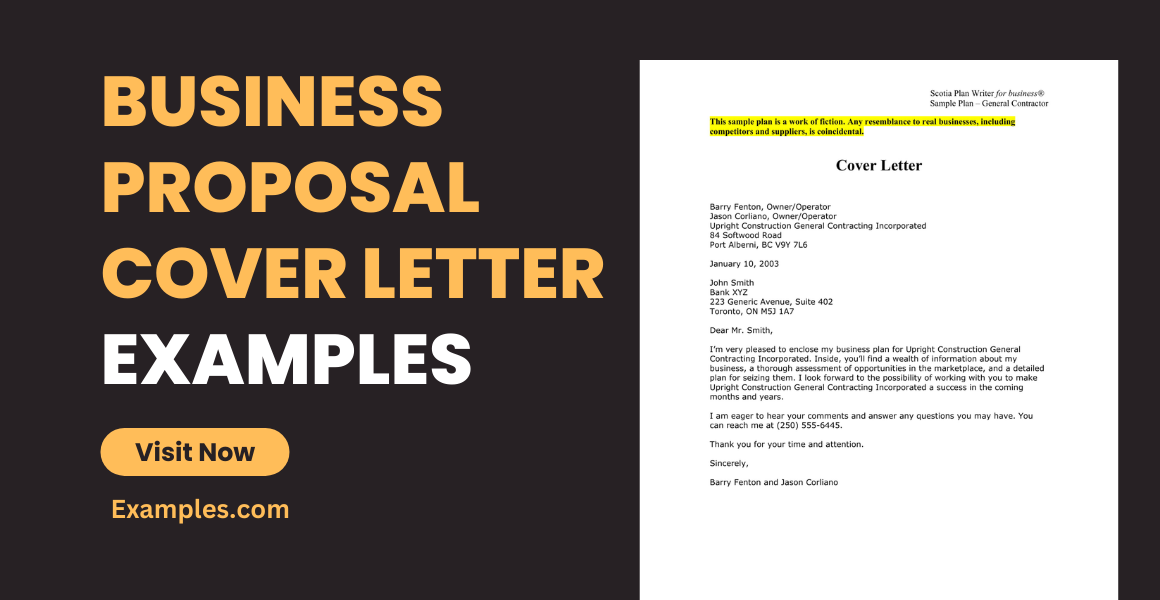
The cover letter of a business proposal is as important as the proposal itself. And it is quite distressing to know that some people do not put the right amount of time and effort in making a cover letter. It is in fact very critical to just see the cover letter as additional work in creating the whole business proposal.
Proponents of business proposals spend countless days and nights perfecting the business proposal but only spend a couple of minutes making a cover letter. Not only does it shout neglect, it can also be interpreted as being unprepared. Remember that the cover letter covers the proposal, it is the first piece of the proposal that the investor sees.
The cover letter directly addresses the person in charge of reviewing your business proposal. It is your chance to blow away and convince the investor to take a chance with your proposal. Neglecting its importance will greatly affect the chances of achieving the intended success of the business proposal. You may also see email cover letter examples.

Importance of a Cover Letter in the Business Proposal
The cover letter of the business proposal is one of the most important parts of the business proposal itself. It has been proven that in general, three parts of the business proposal are examined meticulously; the cover letter/i ntroduction/ executive summary , the costs and the timescales.
The cover letter has a strong correlation with the executive summary of the proposal. Therefore, the cover letter is the stripped down version of the executive summary. It only presents the key points on the major topics of the business proposal. It stands independently on its own; when the investor is unable to read the business proposal as a whole or even the executive summary, the cover letter can still present the major keys of the whole business proposal. You may also see business proposal letter examples.
Your cover letter is your chance to have a personal word with the investor and prepare him/her for what’s in-store. It should state that there is in fact a business proposal attached with the letter and that you are applying for a business loan or to start your own business. It also states the benefits the investor will gain when they invest in your business and it helps you make the investors believe that there is a good return of investment in your business. You may also like application letter examples & samples.
It does not merely introduce what the business proposal is all about, in fact it clearly summarizes the major points made in the executive summary. It carefully distills the message you are trying to relay in your business proposal. And since it is a summary of a summary, it does not need to be lengthy. So long as the major points have been thoroughly discussed and presented, your cover letter is doing just fine. You may also check out professional cover letter examples.
As mentioned before, it also acts as the cover of your proposal. Therefore, it should display your passion, eagerness and desire to fully pursue and work for the intended project. As it aims to convince the investors, important details that greatly affect the whole proposal must be included in the cover letter. You might be interested in business letter examples.
Business Proposal Cover Letter Template
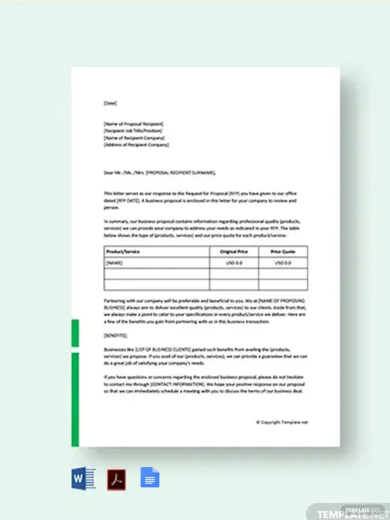
- Google Docs
Size: 87 KB
Business Funding Proposal Cover Letter Template
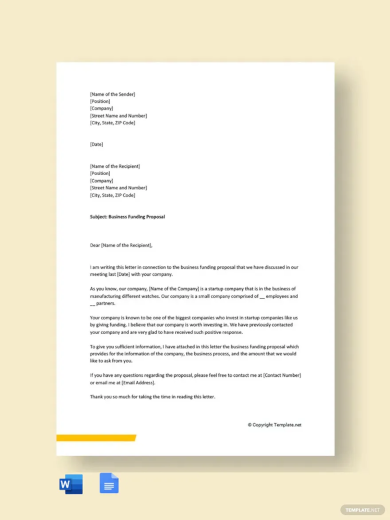
Size: 70 KB
Business Proposal Cover Letter Example

Size: 167 KB
Are you on the lookout for a Nonprofit Cover Letter Examples template? Then, checkout this template now. It not only comes with high quality design but you can also use it in any way you want. The editable and customizable option will make it easier to choose your template design in an efficient way.
Structure of the Cover Letter
Aside from all the necessary parts like the address, greetings, closings, etc. it is important to know the major structure of a cover letter for your business proposal.
1. Introduction
It is the most important part of you letter. It is the hook and it should immediately capture the reader’s attention. You can start it broadly but not too broad that you’ll need to dive into so much detail. However, it is always a better option to be direct and straight to the point. You may also see appointment letter examples & samples.
You introduction must briefly introduce you as the proponent and should carefully explain your purpose and ideas. Shock them with your unique ideas and urge them read more of the letter and the business proposal. It should be captivating and spark interest in your proposal. It is important to clearly but briefly the purpose and goals of your proposal in your letter .
For example, “This letter is intended to formally propose septic tank cleaning services for the Name of Apartment Complex. We have been successfully the number one septic tank draining and cleaning service provider in more than 10 apartment complexes in CITY, for the past 25 years and would be happy to give testimonials from our customers. We respond 24/7 to all emergency requirements and make sure the septic tanks in every apartment is working efficiently.” You may also like complaint letter examples & samples.
The body of your letter should be direct and avoid indecision. It must clearly explain and justify the purpose of your business proposal. ‘Maybes’ and ‘Ifs’ have no place in your letter since nothing breaks trust faster than indecision and being unsure. You have to prove that you are worth every penny that the investor might invest in your proposal. You may also check out reference letter examples.
It communicates how qualified you are as the proponent in implementing the proposal. The body should provide evidence of your qualifications and the study you have conducted in the feasibility of the proposed subject. It should be clear to the investors that you have given your proposal enough thought, study and research so that can trust your vision. You might be interested in employee reference letter samples .
Eliminate the possibility of doubt. The investor must fully understand your objectives and how you plan to achieve them. Always highlight your qualifications but avoid sounding conceited. For example you can describe how adequate you are in the field, how well trained your team is or how advance your equipment are. This will let the investor know that you or your company are entirely capable of doubling what they invest. You may also see new hire welcome letter examples.
3. Conclusion
In the conclusion, always invite them to read the business proposal as a whole. It’s always a welcomed lead-on to encourage the reader to read the rest of your proposal since you have provided a well-researched and well-written proposal that supports your claims. You may also like official resignation letter examples.
Always aim to encourage them to take a chance on reading and understanding the rest of your proposal since it is the main purpose of your cover letter. Most importantly, include your contact information in the closing of your letter so they know when and where to reach you whenever they need further discussion on the matter. You may also check out termination letter examples & samples.
Foundation Proposal Cover Letter Example
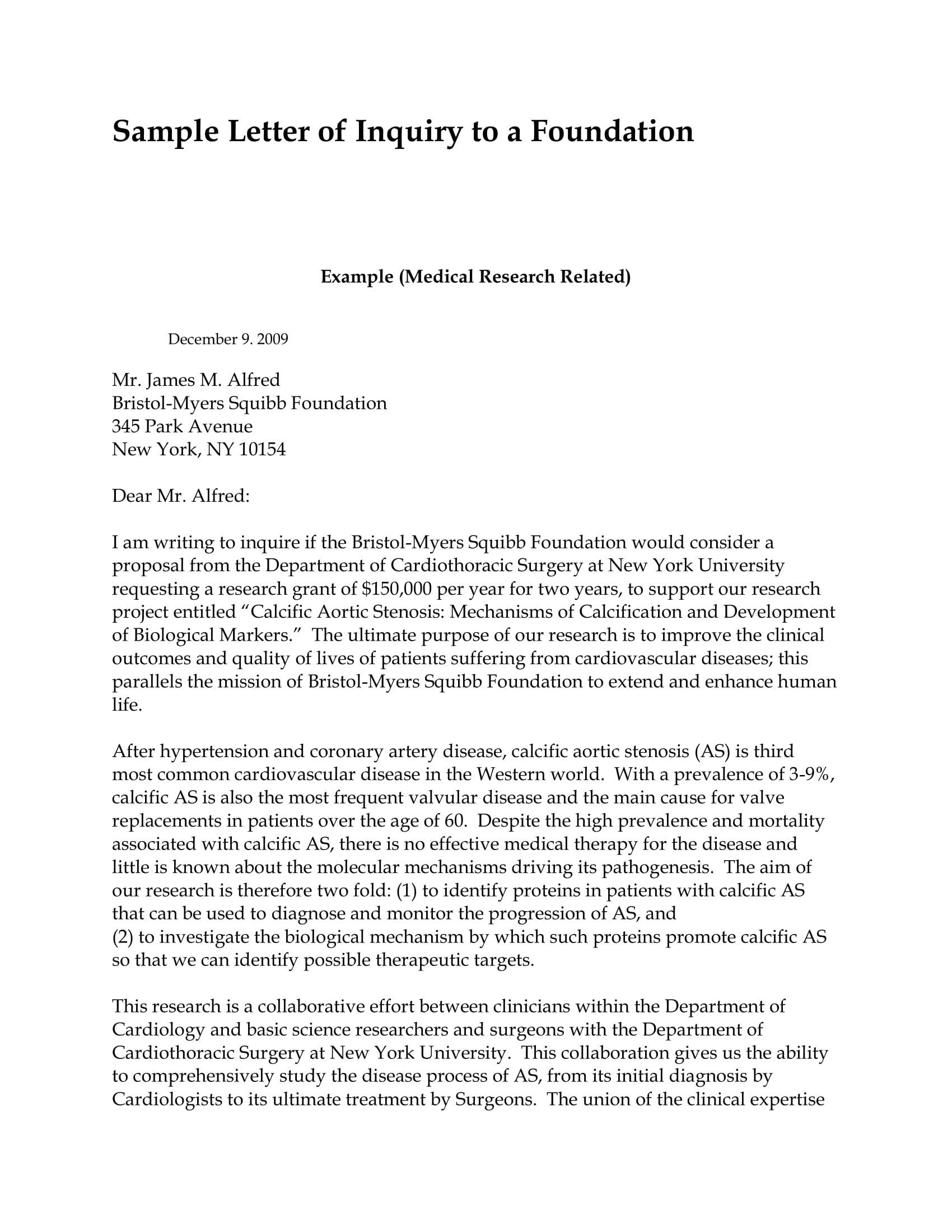
Size: 295 KB
Editable Business Proposal Cover Letter Example
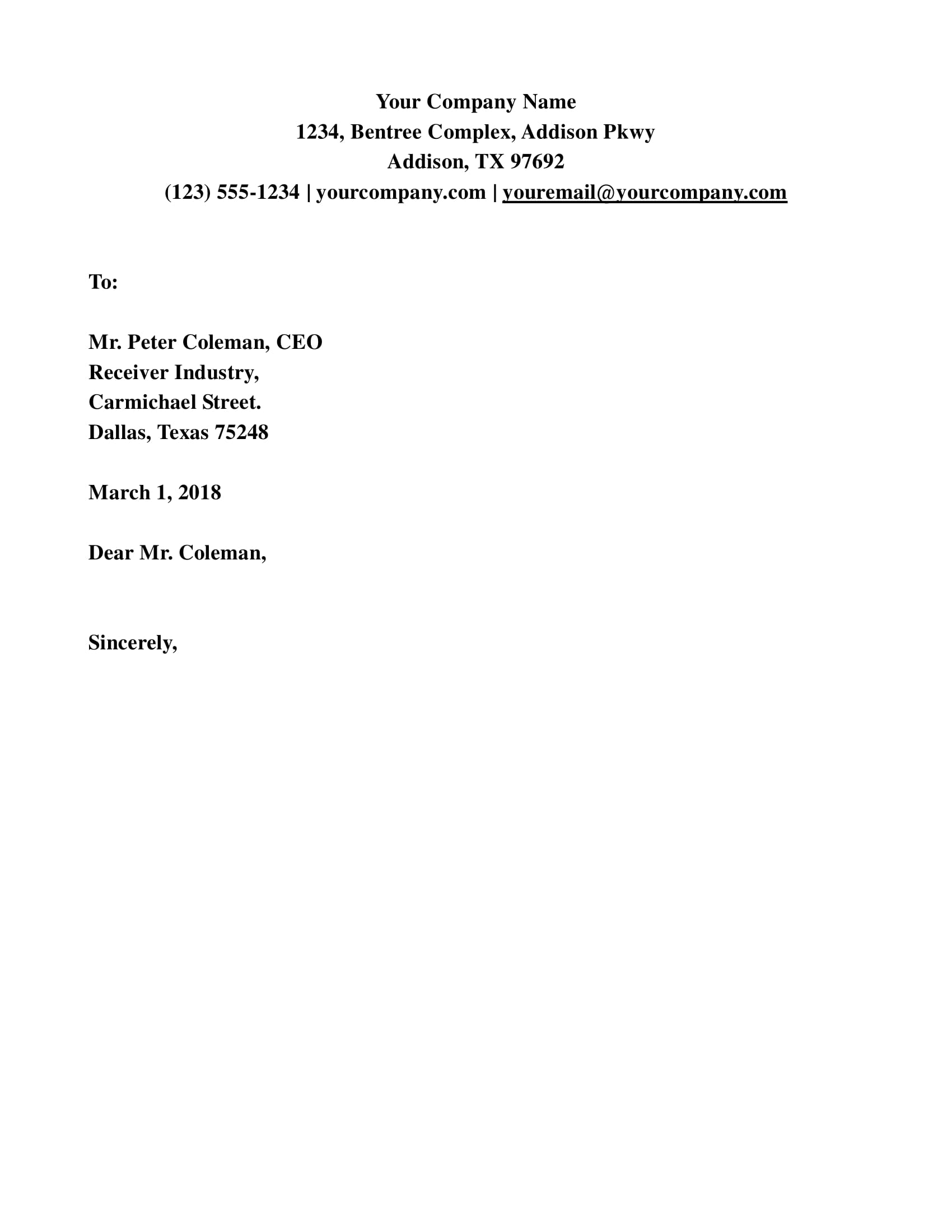
Size: 60 KB
How to Write a Business Proposal Cover Letter
1. Should you decide to use an electronic format or even yet a video and go paperless, it is also acceptable. However, if you want to pursue the traditional way, the cover letter of your business proposal must be in a business or professional format. It must follow the structure of basic business letter .
You can start with the basic format before the actual content. The header of your letter should include the name of your company, your address, and your contact information. You can then add the name of the recipient along with his/her designation and their company’s contact information. Do not forget the date in your letter. Then, address the recipient with his/her title, for example, Mr. Ms. Mrs. Engr., etc. After so, choose the right closing for your letter like ‘Sincerely’ or ‘Respectfully.’ At this point your letter should look like this:
2. Depending on the nature the proposal, it can either be solicited or unsolicited, the requirement for the proposal or the problem to be addressed must be discussed. If the proposal is solicited, ask yourself why the investor has sought out your products or services, or what problems do they have that you can easily solve. In this way, you can start the introduction of your letter accordingly. For example in a solicited proposal you can start by saying: “As we discussed in our last meeting…” and then immediately state the issue/requirement in the same single sentence. You may also see how to write a personal letter with examples .
If you are submitting an unsolicited business proposal, start your letter immediately with a hook. You need to truly shock your readers so they can be encouraged to read more. Stating a pertinent question always works or monetary consequences of a problem to evoke strong emotions. For example, “How would you like to increase your sales by 50% in the next 6-months while lowering your marketing expenses?” or “An average company loses $1,000 every day on electrical wastage! Our solution eliminates that electrical waste.” You may also like notice letter examples .
3. Advertise what you can bring to the table. Tell your readers that you have conducted studies to help prove that you can be a big asset to the company. Talk about the analysis you conduct to help figure out the problem and the solutions you can and will provide. State the results of those studies that back up your claims. It can be presented in a bullet point format following an sentence or two about the analysis. The list should clearly explain the goals you try to achieve through your product and//or services. You may also check out recommendation letter examples & samples .
For example:
“We will analyze/have analyzed (as may be applicable) the complete operation of your company and we have found that through the use of our service, your company will:
- Increase brand awareness
- Increase marketing ROI by over 50%
- Rationalize your pre-sales and post-sales process
- Acquire new client segments including the untapped local client base, and lower your new client acquisition costs by over 30%”
4. In this step, it is important to realize that this doesn’t mean highlighting the features of your product or services. This is when and where you clearly explain the benefits the investor will have from your proposal. You should clearly state what the investor will receive upon purchasing your products and/or services. For example, “By using this approach to the whole operation process, we can help your company increase revenue by over 50% while at the same time creating an excellent environment for your future products.” You may also see vehicle expense reimbursement policy letter .
It is also optional to include you qualifications as the proponent. You can mention why and how you or yur company is the best option to handle the issue over the others.
5. Finally, as the conclusion of your letter or video, you have to tell the recipient what you want him/her to do next. This is a blatant but very much necessary to do so since this is the call-to-action part of your letter. This can be encouraging the recipient to read the rest of the proposal or urging him/her to get in touch in order to discuss the proposal in person. In this case, you have to include your relevant contact information so the recipient can easily get in touch. You may also like how to write a job resignation letter .
By the end of all of these steps, your letter will look like this:
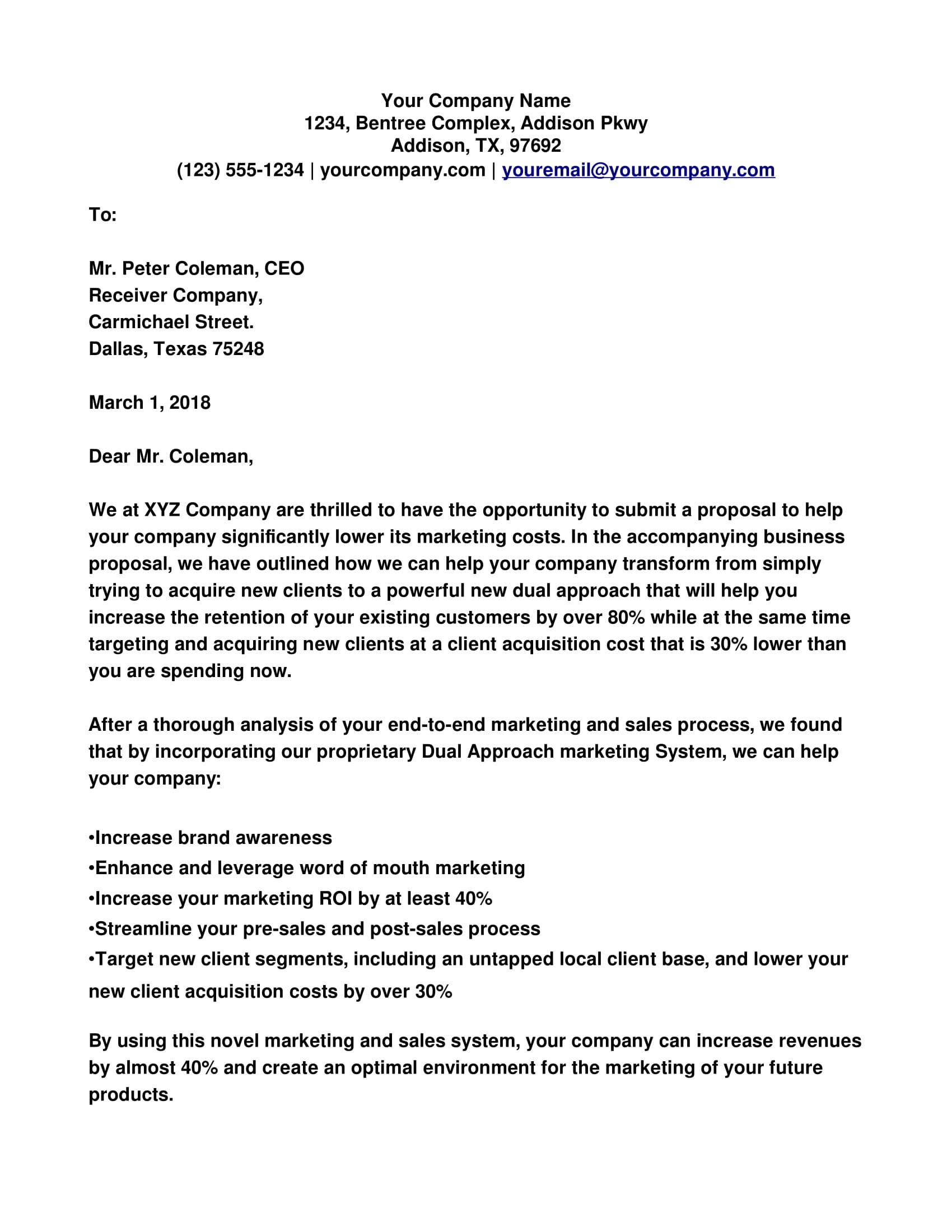
Size: 256 KB
In conclusion, a cover letter for a business proposal is a vital part of the whole. It introduces not only you as the proponent but also the main purpose and the goal of the proposal as well. It briefly explains the major points made in the content and the whole proposal and prepares the reader for what he/she is about to read. You may also see how to write an official letter .
We hope we were able to clearly explain the importance and how to write your own cover letter for you business proposal.
Text prompt
- Instructive
- Professional
Generate a proposal for a new school recycling program
Compose a proposal for a school field trip to a science museum.

Proposal Manager Cover Letter Examples
Use these Proposal Manager cover letter examples to help you write a powerful cover letter that will separate you from the competition.

Proposal managers are responsible for creating and managing proposals for their company. They need to be able to write well, understand complex concepts, and have strong organizational skills.
When you apply for a proposal manager position, you need to show that you have the skills and experience necessary to do the job. Use these examples to write a cover letter that will help you stand out from the competition.
Formal/Professional Writing Style Example
With a strong background in proposal management, excellent communication skills, and a proven track record in driving successful bids, I am confident in my ability to contribute substantially to your team and make a positive impact on your proposal initiatives.
With over five years of experience as a Proposal Manager at XYZ Solutions, I have managed the entire proposal development process, from pre-solicitation to submission, for numerous commercial and government clients. My responsibilities included coordinating resources, establishing timelines, creating proposal outlines, and working closely with subject matter experts to develop accurate and persuasive content. I am skilled in interpreting complex solicitation requirements, ensuring compliance with client specifications, and conducting thorough reviews to maximize proposal quality.
My cross-functional collaboration skills have allowed me to forge strong working relationships with technical, sales, and marketing teams. Furthermore, my keen attention to detail and ability to remain calm under pressure have been essential in delivering winning proposals within tight deadlines.
In addition to my professional experience, I hold a Bachelor’s degree in Business Administration and am certified as an APMP Proposal Practitioner. These educational qualifications, along with my passion for continuous professional development, have heightened my understanding of industry best practices and provided me with a strong foundation in proposal management.
I am enthusiastic about the opportunity to contribute my skills and expertise to your organization and am confident that my background would make me a valuable asset to the team. I look forward to the prospect of discussing my candidacy further and appreciate your consideration.
[Your Name]
Entry-Level Writing Style Example
As a recent graduate with a Bachelor of Business Administration and a specialization in marketing from XYZ University, I am eager to kick-start my career with an organization that values innovation and teamwork, such as ABC Company.
During my time in university, I had the opportunity to work on numerous group projects that required us to develop, write, and present our proposals to both classmates and professors. This experience has equipped me with a strong understanding of proposal development processes and the ability to create and maintain proposal documentation. In addition, my excellent communication skills and the ability to work in a fast-paced environment will make me an invaluable member of your team.
My passion for writing and attention to detail will ensure that all proposals I create are of the highest quality. Furthermore, my experience in working with diverse teams will allow me to effectively collaborate with various departments and contribute to the overall success of the company.
I am excited about the opportunity to work with ABC Company and contribute to its growth and success. It would be a pleasure to meet you in person to further discuss my qualifications and how I can contribute to the company’s goals as a Proposal Manager.
Thank you for considering my application. I look forward to the prospect of joining your team.
Networking/Referral Writing Style Example
I was referred to this opportunity by Jane Smith, your Senior Project Manager, who thought that my skills and experience align well with your requirements.
During my time working with Jane at XYZ Company, I demonstrated strong proposal development and management skills, and we successfully executed numerous complex projects together. I believe my track record of consistently delivering high-quality proposals that not only meet but exceed client expectations makes me an ideal fit for this role.
In my current position as a Proposal Manager at ABC Corporation, I have overseen the creation and delivery of more than 50 proposals in the last two years, with a close rate of 80%. My expertise in identifying client needs, building a cohesive team, and implementing best practices has continuously led to successful wins for our clients.
Furthermore, I hold a certified expert in the RFP process and possess extensive knowledge of industry trends and regulatory requirements, ensuring that my proposals are always up to date and compliant.
I have great respect for the work you do at [Company Name] and strongly believe that my skillset and experience make me a suitable candidate for this role. I would be honored to have the opportunity to contribute to your company’s continued growth and success.
Thank you for considering my application. I look forward to discussing my qualifications further.
Enthusiastic/Passionate Writing Style Example
As an avid follower of your company’s innovations and achievements, I am thrilled to see the opportunity to contribute my creative problem-solving skills and focused determination to help drive continued success in this role. I am eager to apply my background in proposal development and management, coupled with my unwavering determination to exceed client expectations, to ensure each project advances smoothly from conception to fruition.
Having honed my skills in both writing and reviewing proposals across various industries, I have developed a keen eye for detail and a strong understanding of what makes a proposal stand out. My experience in collaborating with cross-functional teams has solidified my ability to build consensus, maintain open communication, and effectively manage diverse tasks under tight deadlines.
But above all, what truly sets me apart is my profound dedication to delivering excellence. I am deeply passionate about creating persuasive proposals that captivate readers and inspire confidence in the organizations I serve. I’m not just interested in fulfilling the duties of a Proposal Manager; I am driven by a powerful enthusiasm for making a difference, and I am eager to channel this into generating outstanding results for your company.
I look forward to the opportunity to speak with you more about my qualifications and bring the same energy and dedication that has propelled my success to date into the Proposal Manager role at your company. Thank you for considering my application, and I hope to have the chance to combine my passion with your organization’s vision to reach greater heights together.
Problem-Solving Writing Style Example
I am aware that in today’s fast-paced and highly competitive business world, the ability to produce winning proposals is crucial to the growth and success of a company. Recognizing the challenges your organization faces in consistently delivering exceptional responses to client requests and generating new business opportunities, I strongly believe that my skills and experiences can make a significant impact in driving results.
Throughout my career, I have developed a keen understanding of the bid lifecycle and have successfully managed proposal development from inception to submission. My background in technical writing, paired with my proven management skills, render me the perfect candidate to oversee cross-functional teams and ensure alignment throughout the entire process.
One particular challenge I have faced in my previous experience as a proposal manager was the lack of a streamlined system to manage RFP responses, resulting in inefficiencies and missed deadlines. To tackle this issue, I led the implementation of a robust proposal management software, which reduced error rates by 30% and increased win rates by 15%. I am confident that similar initiatives would greatly benefit your organization as well.
Beyond my core competencies, I have cultivated outstanding communication and persuasive writing skills, both of which are essential for crafting compelling and tailored proposals. My ability to adapt my style to address client needs and decisively articulate the value proposition will further contribute to your company’s ability to secure new business.
In conclusion, my experience in proposal management and my proactive approach to identifying and mitigating challenges make me an ideal candidate for the Proposal Manager role. I am excited about the opportunity to join your team and help your company achieve its strategic growth objectives.
Thank you for considering my application. I look forward to the opportunity to speak with you further about how my skills and experiences can contribute to the success of your organization.
Storytelling/Narrative Writing Style Example
As I strolled through the park on a warm autumn day, I stumbled upon an unusual sight – a group of people gathered around a table, immersed in a heated discussion. Intrigued, I walked closer and soon discovered that they were debating the best approach to drafting a proposal for a local community project. Unable to resist the pull of such a fascinating conversation, I offered my suggestions and found myself becoming deeply involved in the discussion. It was at this moment that I realized my true passion for crafting proposals, and I knew that my experiences and skills made me the perfect candidate for the Proposal Manager position at your company.
In my previous roles, I have successfully managed a diverse range of proposals, from small-scale community initiatives to large international projects, resulting in increased funding and partnerships for the organizations I have served. My ability to analyze complex requirements, collaborate effectively with cross-functional teams, and deliver compelling, persuasive proposals has consistently proven to be my greatest strength.
My background in project management and business development has prepared me well for this role. I am well-versed in conducting in-depth research, analyzing market trends, and developing tailored strategies to meet clients’ needs. Additionally, my excellent communication skills and attention to detail enable me to create proposals that are not only engaging but also accurate and comprehensive.
I am confident that my passion for crafting winning proposals, combined with my extensive experience and strong skill set, make me an ideal candidate for the Proposal Manager role at your organization. I would love the opportunity to contribute my expertise to your team and help drive success in your ongoing and future projects.
Thank you for considering my application. I look forward to the opportunity to discuss my qualifications further.
Commissioners-designate (2024-2029)

On 18 July 2024, European Commission President Ursula von der Leyen , who was elected for a second mandate, presented to the European Parliament her Political Guidelines for the next European Commission 2024-2029. Watch her address to the Parliament's plenary on EbS+ or read it on the Press Corner .
See also the list of Commissioners-designate and their portfolios, reflecting the ambitions set out in the Political Guidelines.
Commissioners-designate appear in public hearings at the European Parliament. After that, the Commission as a whole is approved in a single vote of consent by the Parliament. The European Council, acting by qualified majority, formally appoints the Commission’s new leadership.
Download the list of Commissioners-designate and their portfolios here .
Commissioners-designate

Portfolio: Executive Vice-President for Clean, Just and Competitive Transition
More information
- Mission letter to Teresa Ribera Rodríguez

Portfolio: Executive Vice-President for Tech Sovereignty, Security and Democracy
- Mission letter to Henna Virkkunen

Portfolio: Executive Vice-President for Prosperity and Industrial Strategy
- Mission letter to Stéphane Séjourné

Portfolio: High Representative for Foreign Affairs and Security Policy and Vice-President of the European Commission
- Mission letter to Kaja Kallas

Portfolio: Executive Vice-President for People, Skills and Preparedness
- Mission letter to Roxana Mînzatu

Portfolio: Executive Vice-President for Cohesion and Reforms
- Mission letter to Raffaele Fitto

Portfolio: Commissioner for Trade and Economic Security; Interinstitutional Relations and Transparency
- Mission letter to Maroš Šefčovič

Portfolio: Commissioner for Economy and Productivity; Implementation and Simplification
- Mission letter to Valdis Dombrovskis

Portfolio: Commissioner for Mediterranean
- Mission letter to Dubravka Šuica

Portfolio: Commissioner for Health and Animal Welfare
- Mission letter to Olivér Várhelyi

Portfolio: Commissioner for Climate, Net Zero and Clean Growth
- Mission letter to Wopke Hoekstra

Portfolio: Commissioner for Defence and Space
- Mission letter to Andrius Kubilius

Pending formal nomination. National proceedings ongoing
Portfolio: Commissioner for Enlargement
- Mission letter to Marta Kos

Portfolio: Commissioner for International Partnerships
- Mission letter to Jozef Síkela

Portfolio: Commissioner for Fisheries and Oceans
- Mission letter to Costas Kadis

Portfolio: Commissioner for Financial Services and the Savings and Investments Union
- Mission letter to Maria Luís Albuquerque

Portfolio: Commissioner for Preparedness and Crisis Management; Equality
- Mission letter to Hadja Lahbib

Portfolio: Commissioner for Internal Affairs and Migration
- Mission letter to Magnus Brunner

Portfolio: Commissioner for Environment, Water Resilience and a Competitive Circular Economy
- Mission letter to Jessika Roswall

Portfolio: Commissioner for Budget, Anti-Fraud and Public Administration
- Mission letter to Piotr Serafin

Portfolio: Commissioner for Energy and Housing
- Mission letter to Dan Jørgensen

Portfolio: Commissioner for Startups, Research and Innovation
- Mission letter to Ekaterina Zaharieva

Portfolio: Commissioner for Democracy, Justice, and the Rule of Law
- Mission letter to Michael McGrath

Portfolio: Commissioner for Sustainable Transport and Tourism
- Mission letter to Apostolos Tzitzikostas

Portfolio: Commissioner for Agriculture and Food
- Mission letter to Christophe Hansen

Portfolio: Commissioner for Intergenerational Fairness, Youth, Culture and Sport
- Mission letter to Glenn Micallef
- 17 SEPTEMBER 2024
- Deutsch (2.79 MB - PDF) Download
- français (2.79 MB - PDF) Download
Share this page

IMAGES
VIDEO
COMMENTS
A cover letter for a proposal is one of the first pages of a proposal and functions as an introduction. Proposals are packages of documents that request money from a donor to fund a particular project. One of the most common types of proposals is a grant proposal, in which organizations, typically nonprofits, ask philanthropic foundations for ...
Step 1: Read the RFP Cover to Cover. This step seems obvious, but it's surprising how many teams skip it. You must read the RFP thoroughly, from cover to cover, before beginning your letter. While reading, take note of any recurring themes from your prospect. Perhaps they focus on quality of design and ease of use.
A proposal cover letter is a letter that accompanies an RFP response or bid submission. Its primary purpose is to introduce the proposal, explain its relevance to the recipient, and persuade the reader of the value and credibility of what's being offered. It sets the tone for the entire proposal, so make sure it's well-crafted.
A proposal cover letter is a one-page document that helps you pitch your offer to a client, business partner, or any kind of prospect you want to do business with. It is usually written as a response to an RFP (Request For a Proposal) and can sometimes be referred to as a cover letter for an RFP .
7 steps to write a proposal cover letter. The compact nature of the proposal cover letter makes it difficult to fit everything in one or two pages. Good writers are valuable assets in these instances. Every proposal cover letter should contain the following sections: Thank the issuer (and broker, where applicable) for the opportunity.
Make sure to highlight the key benefits, focusing on what's in it for your reader. Be specific and use facts, figures, and examples to support your claims. Keep your paragraphs organized and use bullet points or bold text to emphasize important information. For example: Benefit 1: Reduction in production costs by 30%.
Both the cover letter and the executive summary perform the same function. Still, each has a different purpose: the former being more of an introduction and an elevator pitch aimed at securing a client's attention, and the latter is generally inside the proposal itself, highlighting the methodology and expected outcomes of the whole proposal.
If you received a formal request for proposal (RFP), you'll know exactly who to address. Once you do that, highlight your reason for sending the proposal - i.e. the problem at hand and your solution for it. As you can see in our proposal letter template, you should keep it brief and get straight to your points.
First, a proposal cover letter and an executive summary have some things in common: They should appear at the beginning of your proposal. They should be one page long, maximum. They should be prospect-focused. They should NOT be overly sales-y or pitchy. They should NOT be a detailed rehash of the entire proposal.
Your signature. As you're writing, do your best to match the style and tone you've chosen, but you can always tweak it to perfection as you edit. 5. Proofread before you send. The proposal letter is your first impression. Get it right, and there's a good chance the recipient will read your proposal.
First things first, you should open your proposal cover letter with the right question. You can begin by addressing the client's problem right away so that you don't waste any precious time. Then, follow it with the solutions you have for said issue. Another great method would be to get straight to the point.
A proposal cover letter introduces the company seeking funding and shares its vision, thus helping funders to understand the company and its project. Writing a compelling grant proposal involves formatting your proposal professionally, selecting and including the relevant information about the company and project, and aligning it with the ...
A proposal cover letter is a one-page document that provides a brief introduction of your organization and the nature of your proposal. Some people don't include a cover letter in their project proposals, but just like an executive summary, this document sets the mood of your paper. It is where you express that you understand their needs.
At minimum, your cover letter should: Request your dollar amount and introduce your project in the first sentence. Describe how your project and/or organization will further the foundation's mission. Reference your most recent contact with the foundation. List the proposal's contents. Give contact details in case the funder wants additional ...
If you're planning to write a cover letter for your grant proposal, here are some helpful steps you can follow: 1. Use a formal header. At the top of a grant proposal cover letter, most professionals choose to include a formal header. In this section, you can include elements such as: Your contact information.
Here we go - your opportunity to finally talk about YOU. Sort of. Highlights make up the meat of your proposal cover letter. They respond to the client's pressure points (identified above) in more detail, supporting the solutions you provide with your past experience. Your highlights might be additional challenges with teased solutions, or ...
Proposal cover letter sample #2. In this sample, your cover letter is approached with a more formal tone and is for a client who is looking for support in their product strategy. Hello Ms. Thompson, I'm pleased to present you the request for Project Strategy Proposal. In this document, you'll find outlined the goals and objectives, the scope of ...
Proposal letter example Here is an example of a proposal letter for a business plan: Sarah Johnson Pro Design LLC 555 Silver Lane Raleigh, NC 27513 Dec. 5, 2022 Garrett Williams Marketing Masters 1443 East Drive Raleigh, NC 27514 Dear Mr. Williams, Our team at Pro Design enjoyed discussing the opportunity to work with you on developing a new website for your company.
The grant proposal cover letter is submitted with the grant proposal or application document. It provides vital information about the project, its background, purpose, and goals. The grant proposal cover letter is used to help persuade the reviewer to provide financial support for the project. The letter can be used by organizations that have ...
The date on the cover letter should match the date of your proposal or application. The letter should be contained to one page, consisting of 3-4 paragraphs. Find the appropriate contact person at the funding organization so you can address your letter to a specific person. The address of the funder should be placed at the top of the letter.
Santa Fe, New Mexico 12345. [email protected]. 555-555-5555. With these tips & cover letter grant proposal sample, you should be well on your way towards writing a strong cover letter for grant proposals. For even more information on how to get a small business grant, check out our guide. If you are looking for more guidance on how ...
Aside from all the necessary parts like the address, greetings, closings, etc. it is important to know the major structure of a cover letter for your business proposal. 1. Introduction. It is the most important part of you letter. It is the hook and it should immediately capture the reader's attention.
Use these Proposal Manager cover letter examples to help you write a powerful cover letter that will separate you from the competition. Cover Letter Insights. Published Apr 5, 2023. Proposal managers are responsible for creating and managing proposals for their company. They need to be able to write well, understand complex concepts, and have ...
On 18 July 2024, European Commission President Ursula von der Leyen, who was elected for a second mandate, presented to the European Parliament her Political Guidelines for the next European Commission 2024-2029.Watch her address to the Parliament's plenary on EbS+ or read it on the Press Corner.. See also the list of Commissioners-designate and their portfolios, reflecting the ambitions set ...